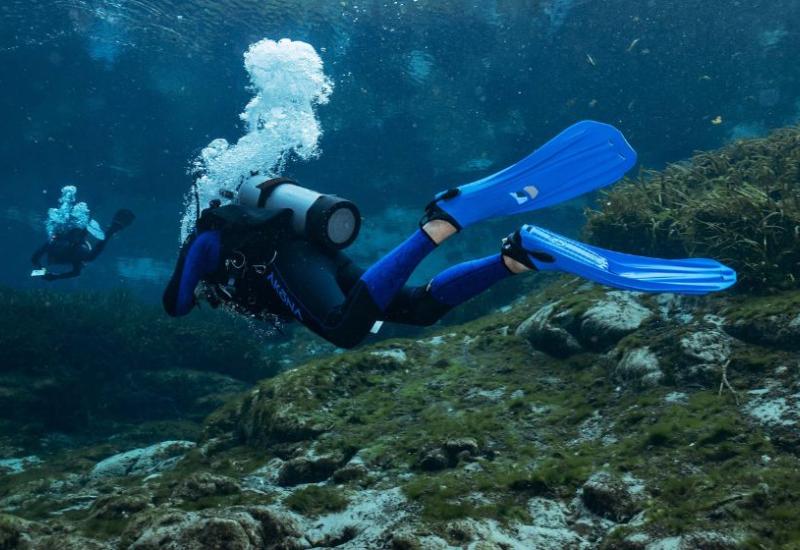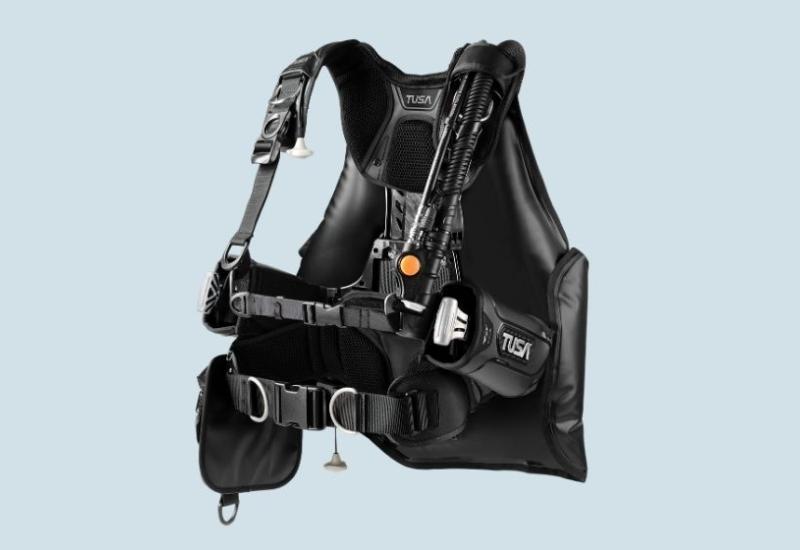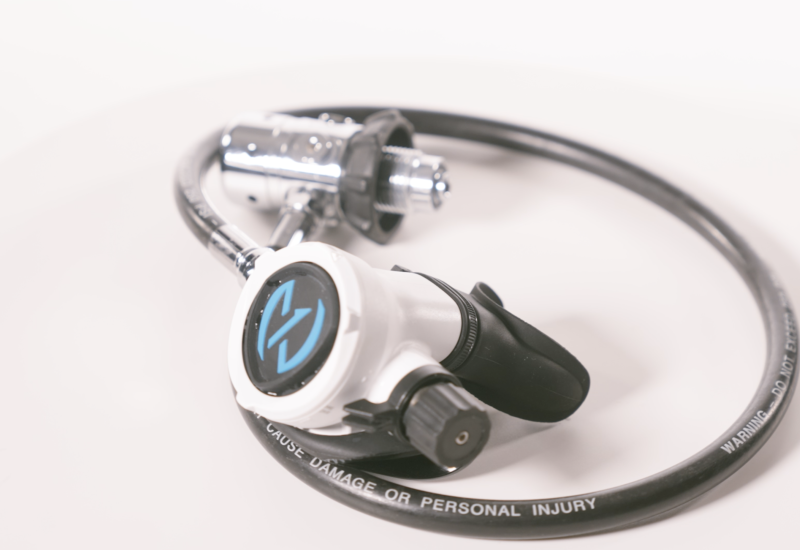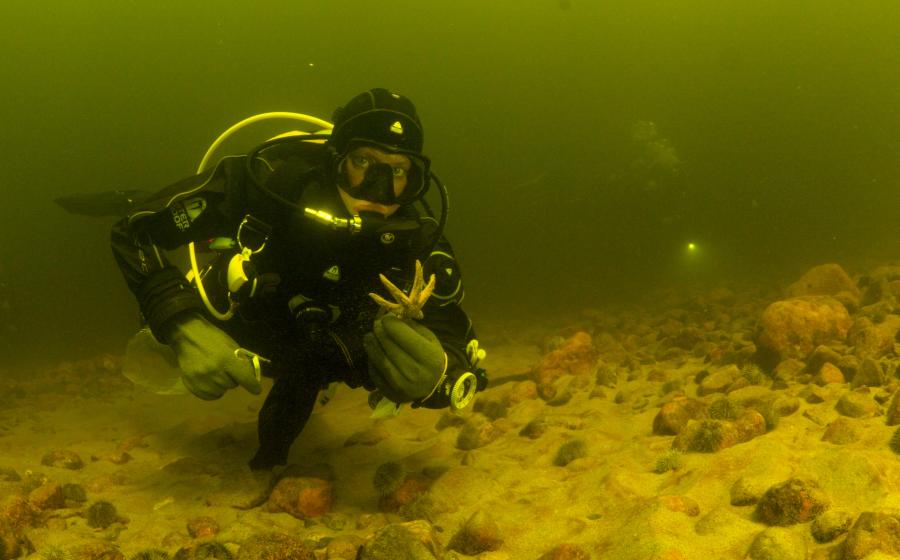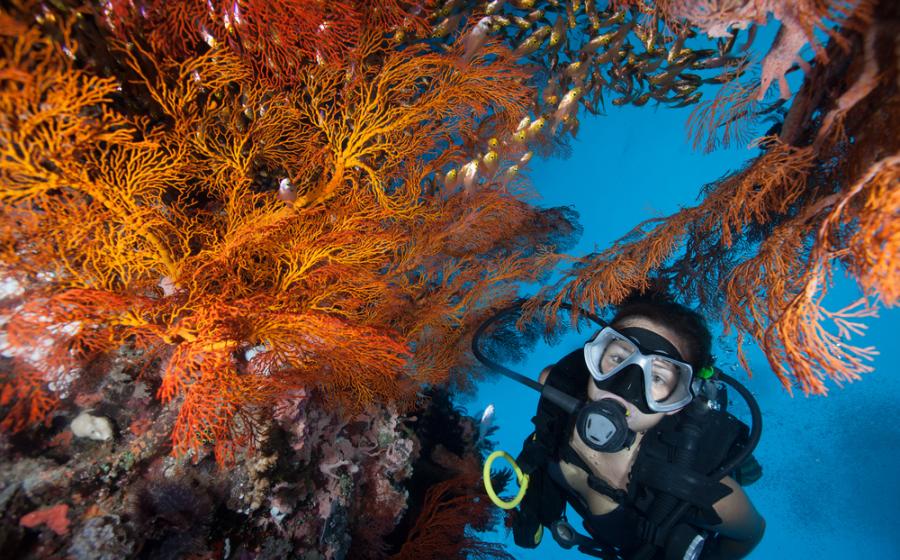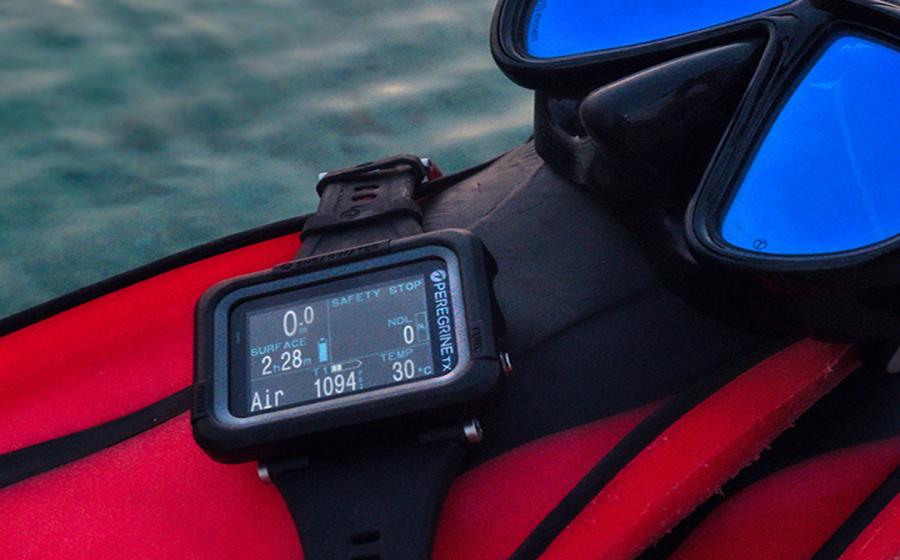ScubaLab: 2013 Scuba Reg Review
The regulator review is the high point of ScubaLab’s annual gear-test program because it’s when we get to peel back the performance layers on what is arguably the most important piece of equipment in a diver’s bag. Clinical testing took place at Dive Lab, which operates the only nonaffiliated ANSTI breathing machine in the country. Then came the ergonomic trials with a test team in the Gulf of Mexico at a site called Airplane Barge off Clearwater, Florida. The reviews presented here are a cumulative summary.
See side-by-side regulator comparisons on our GearFinder tool.
How We Test: Regulators
Breathing Machine Tests:
>> All regs are tested as received from manufacturers.
>> Regs with user adjustments are adjusted for testing at the no-leak/free-flow point. Regs are tested on the breathing machine in a face-forward position, per industry-testing norms. (Note: Regs breathe better in a facedown position, more typical for a recreational diver.)
>> Following a surface check, each reg is tested at three different breathing rates, known as RMVs (Respiratory Minute Volumes, basically the amount of gas that can be ventilated through the lungs in one minute), at three depths, for a total of four RMV/depth combinations. These breathing rates were chosen to enable us to:
- simulate a recreational diver’s breathing rate.
- conform to recognized industry testing parameters for purposes of comparison.
- surpass normal breathing rates to determine reserve capacity (the ability to continue to deliver gas smoothly and easily, even at extreme depths and breathing rates).
>> Simulator tests are not intended to pass or fail regulators, but rather to scientifically gauge their performance based on controlled conditions.
Ergonomic Tests Explained:
ScubaLab staff evaluates each regulator in the water in 13 basic areas. Performance is tracked by numeric scores (1 to 5 – 1 being Poor, 5 being Excellent) and written comments, recorded at depth, while regs are actually being used.
Ergo Test Categories:
- Ease of breathing, swimming position: How well does the regulator deliver air when moving forward in a standard swimming position?
- Ease of breathing, face-up position: How well does the regulator deliver air when you are at depth and looking up toward the surface?
- Ease of breathing, heads-down position: How well does the regulator deliver air when you are at depth and in an inverted position?
- Wetness, swimming position: How dry does the reg breathe?
- Wetness, heads-down position: When in heads-down and face-up, how dry does the reg breathe?
- Bubble interference, swimming position: Taking into account all regulators have bubble interference to a certain degree, when moving through the water, how well does the reg deflect bubbles from your field of view?
- Bubble interference, stationary position: Taking into account all regs have interference to a certain degree, how well does it deflect bubbles from field of view when stationary?
- Ease of clearing, exhalation method: How much force is required to clear the regulator by exhaling?
- Ease of clearing, using purge button: How difficult is it to find and use the purge? How forceful is it?
- Purge-button flexibility: How stiff or pliable is the purge button/cover, and how efficiently does it clear?
- Comfort of mouthpiece: How comfortable is the mouthpiece?
- Venturi lever adjustment: Is the Venturi lever easy to find and use?
- Breating adjustment knob: Is the adjustment knob easy to find and use? Does it do its job in a reasonable manner?
---
Looking for more ScubaLab testing? Check out more of our gear reviews:
CLICK HERE FOR THE LATEST REG REVIEW
For our 2013 Reg Review, ScubaLab tested 17 of the top regulators and picked our favorites based on breathing-machine tests as well as ergonomic tests. The regulator review is the high point of ScubaLab’s annual gear-test program because it’s when we get to peel back the performance layers on what is arguably the most important piece of equipment in a diver’s bag. Clinical testing took place at Dive Lab, which operates the only nonaffiliated ANSTI breathing machine in the country. Then came the ergonomic trials with a test team in the Gulf of Mexico at a site called Airplane Barge off Clearwater, Florida. The reviews presented here are a cumulative summary.
CLICK HERE FOR THE LATEST REG REVIEW
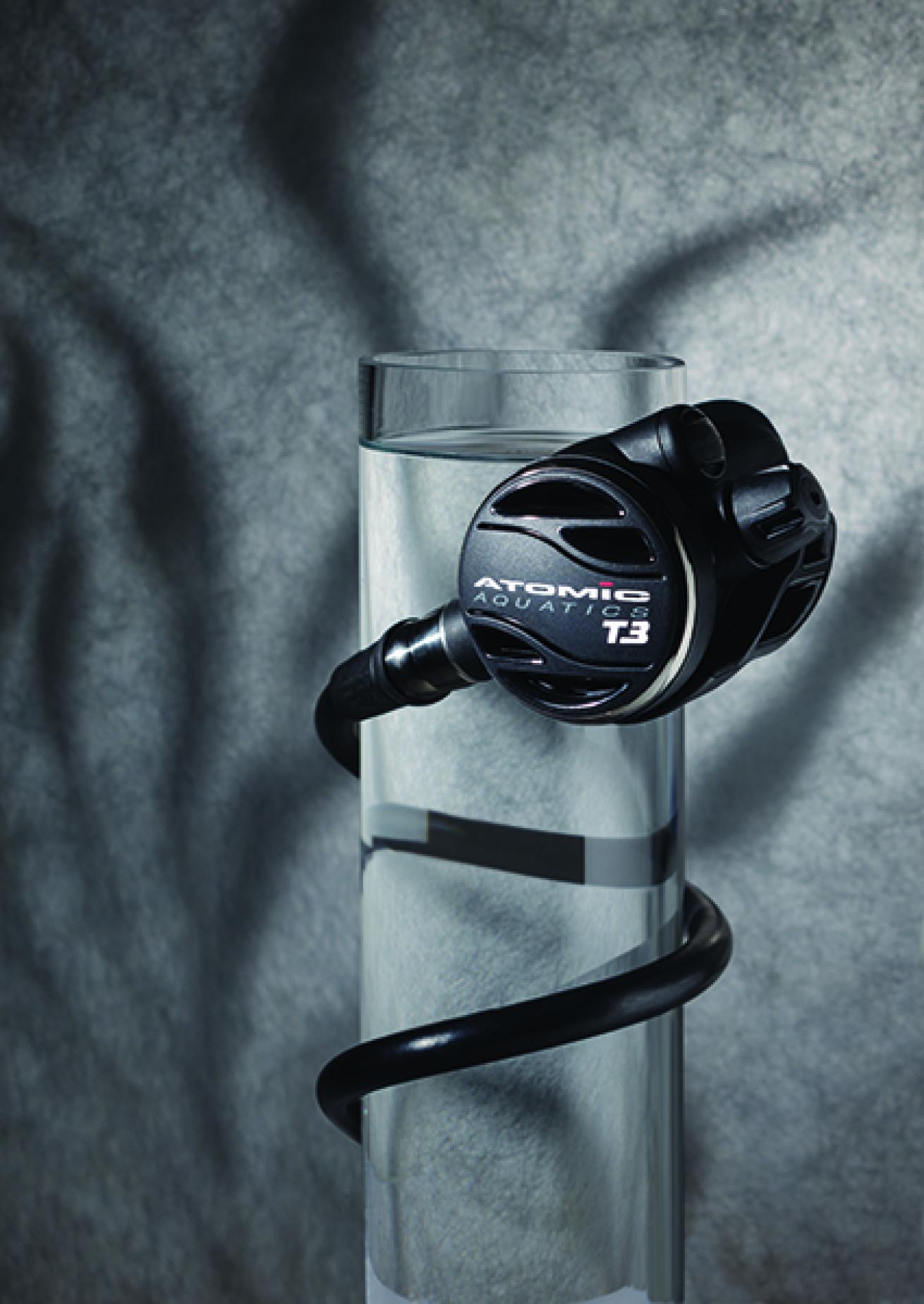
Elly WrayScubaLab Regulator Review
Apeks XTX50
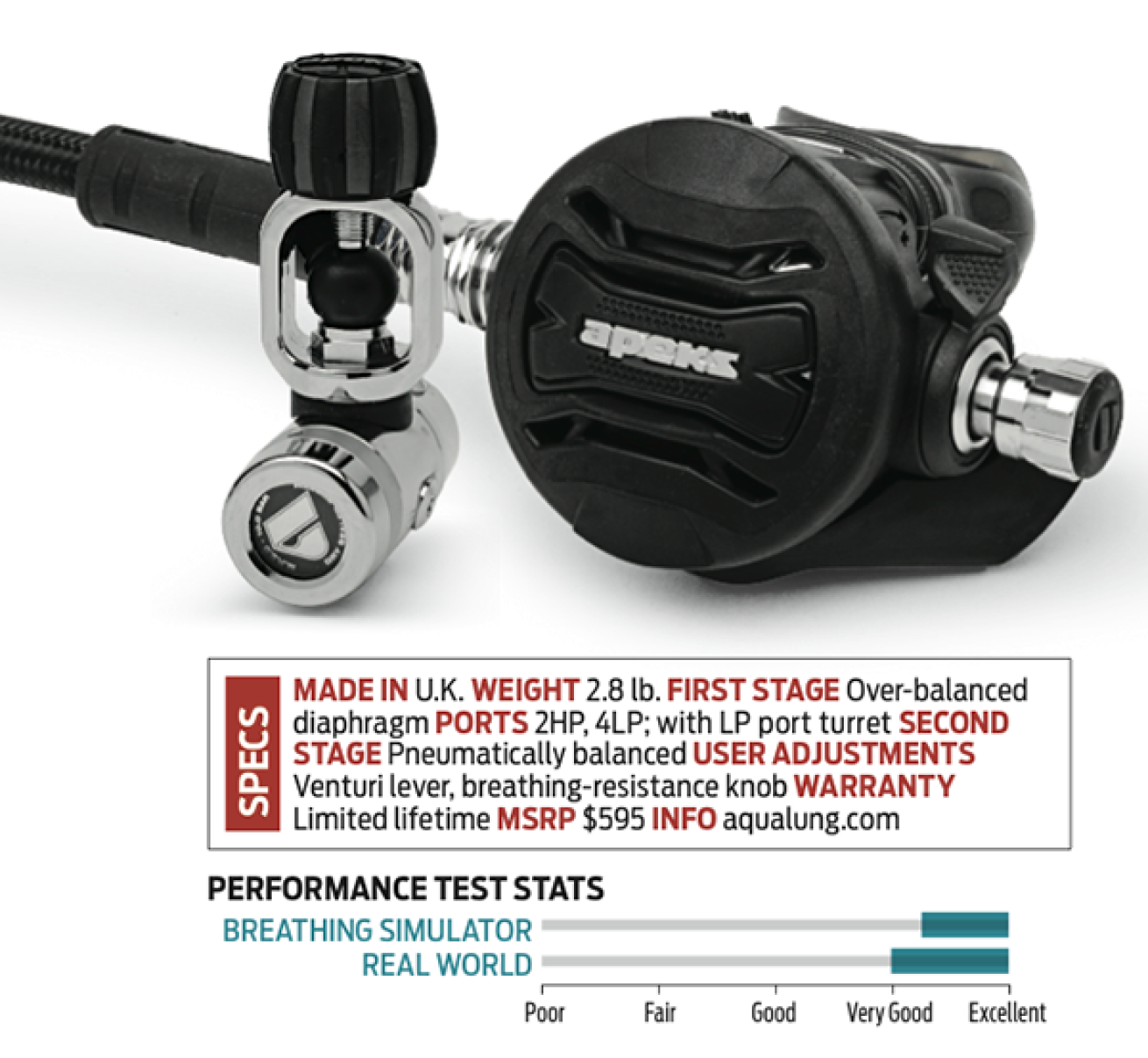
Elly WrayApeks XTX50
PERFORMANCE If you want XTX200 performance but are looking to save some cash, check out the XTX50. Except for some cosmetics, the second stages are identical, with the same left/right reversibility, efficient user adjustments, choice of exhaust tees and ComfoBite mouthpiece. The big difference is in the first stage. The XTX50 first stage, while environmentally sealed like the XTX200, also offers a rotating lP port turret with a new fifth lP port perched on top.
Like its big brother, the XTX50 earned perfect scores in Scubalab’s standard breathing-machine tests, and was even able to dip a toe into the muscle-reg realm. In the ocean, test divers rated the reg’s user adjustments as among the best of this test group. It offers minimal bubble interference, an efficient purge and effortless air delivery in all diving positions.
BOTTOM LINE If you like diving top-end regs, but your wallet’s running on the light side, the XTX50 is a great way to enjoy a lot of breathing performance for not a lot of money.
Apeks XTX200
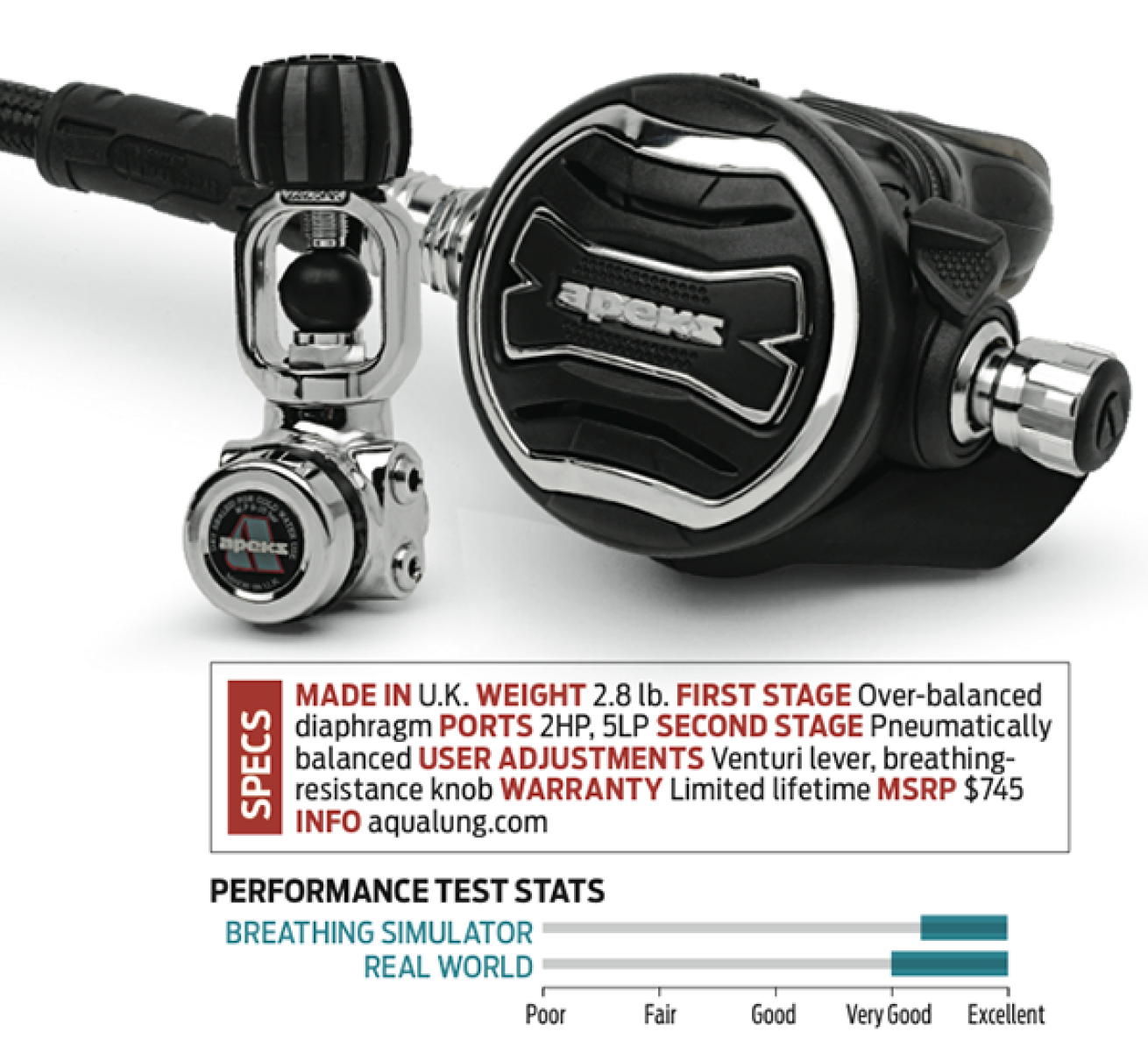
Elly WrayApeks XTX200
PERFORMANCE Apeks’ XTX reg line has been around for almost a decade and includes six different breathing systems. This year the entire line received some upgrades, which prompted us to retest two models to see if anything had changed in the performance department.
Turns out, not so much. The XTX200 — the top dog in the line — is still able to ace breathing-machine tests without breaking a sweat, and in the ocean, it breathes like a dream. For this year, engineers improved the reg’s gas flow and balancing properties (not that it needed it), and added a fifth port to the first stage to increase hose-routing options. The second stage continues to come with a ComfoBite mouthpiece and a choice of exhaust tees. The wider tee does the best job of keeping bubble interference to a minimum, but the narrower tee is lighter and more compact. The reg offers an efficient purge and great user adjustments.
BOTTOM LINE A smooth, dry breather in all swimming positions, the XTX200 is, as one test diver put it, a “kick-ass reg.”
Apollo Sports BAS/A-320 NRX
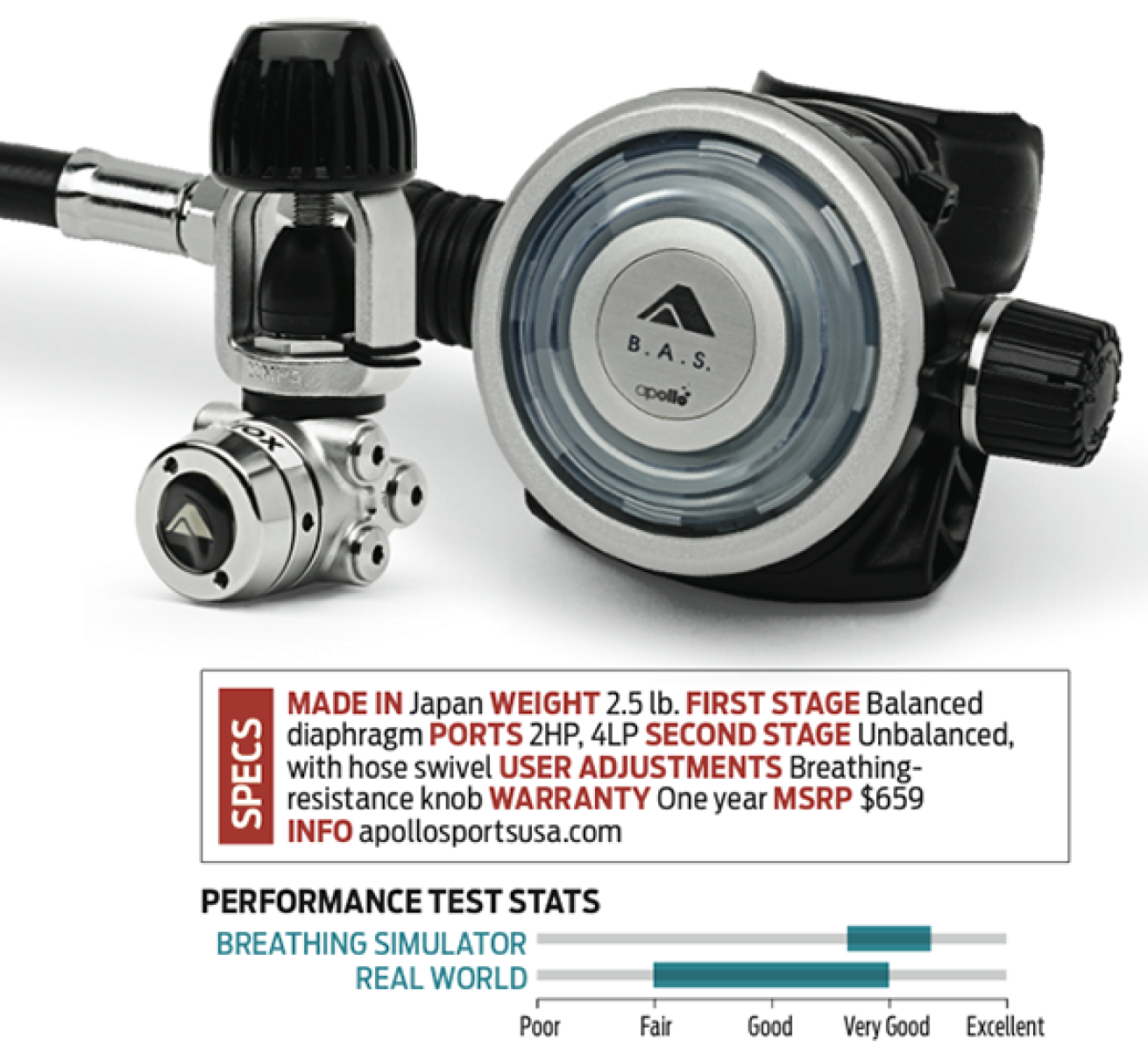
Elly WrayApollo Sports BAS/A-320 NRX
PERFORMANCE This compact breather features an environmentally sealed, satin chrome-plated first stage that can handle tank pressures up to 5,000 psi. It is teamed with the BAS (Bio Air System) second stage that’s equipped with a ball-joint swivel to minimize jaw fatigue, as well as a breathing-resistance knob.
On the ANSTI machine, this reg performed pretty well at the RMV/depth-test level that represents typical recreational diving. But when we took it beyond that, it hit the wall pretty fast. When used by test divers at typical recreational-diving depths, this reg proved to be a near-effortless breather and relatively dry. However, test divers dinged it for a purge that doesn’t feel so stiff when pressing it on the surface but can get a little ornery at depth. The breathing-resistance knob received high marks until it fell off, which prompted comments that the reg looked and felt kind of cheap.
BOTTOM LINE For basic recreational diving, the BAS/ A-320 NRX delivers decent performance, but there are better choices out there for the price.
Aqua Lung Legend LX Twilight
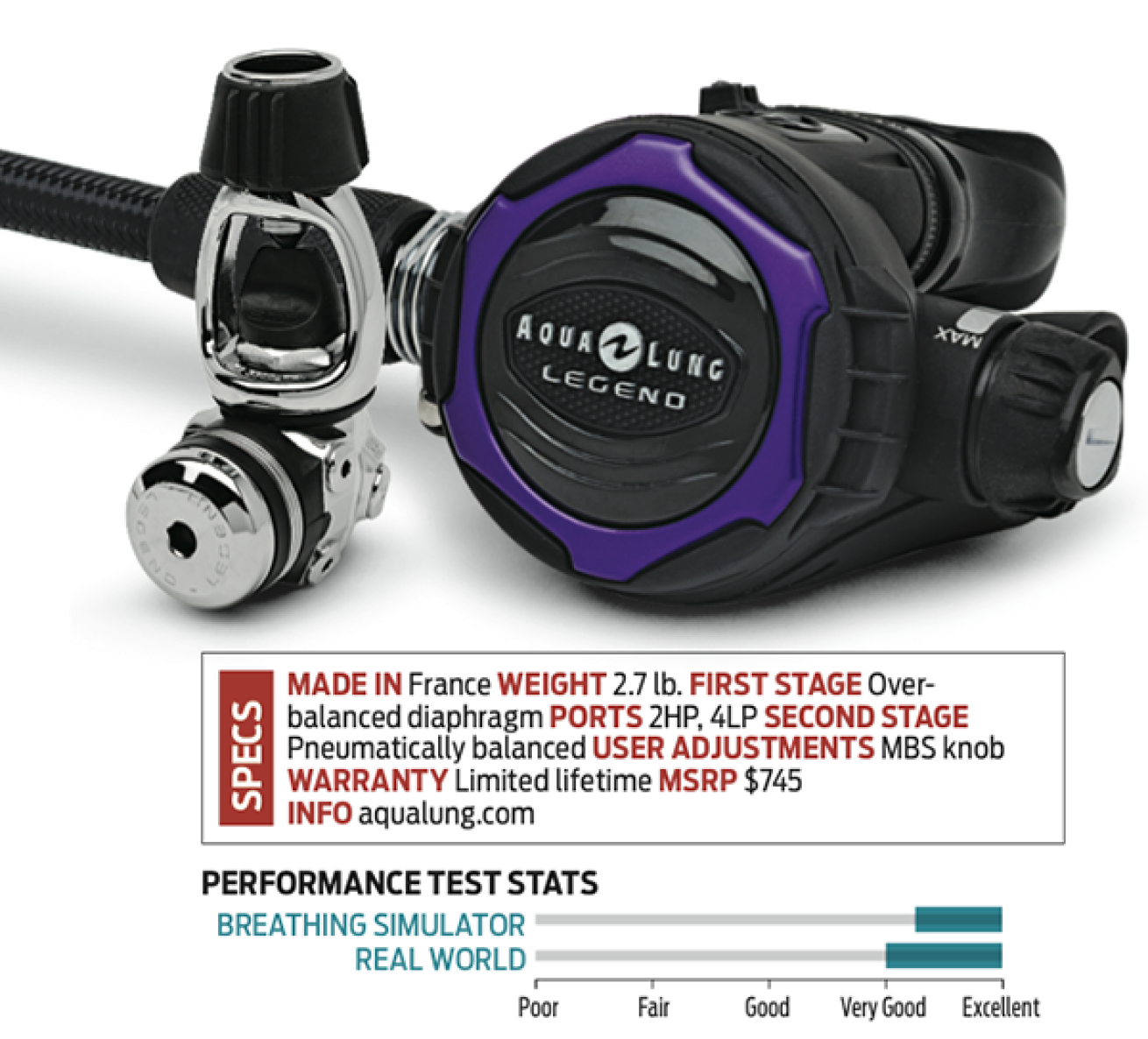
Elly WrayAqua Lung Legend LX Twilight
PERFORMANCE One could argue that the Twilight doesn’t belong in this year’s reg review because it’s basically just a Legend LX with a fancy faceplate and a smaller mouthpiece, both designed to wow female divers. OK, it might be part of Aqua Lung’s new Twilight line of women’s dive gear, but it’s such a great reg, who could blame us for wanting to get it wet again?
Performancewise, the Twilight is pure Legend. It conquered the breathing machine with the lowest actual work of breathing of any reg in this go-round. Then it moved into muscle-reg territory and left its mark there too. During the ocean work, the Twilight turned in from above-average to excellent scores in all ergo categories. Beyond enjoying great breathing performance, testers gave kudos to the Master Breathing System (MBS) user control that acts as a Venturi adjustment plus regulates breathing resistance.
BOTTOM LINE Earning a strong third-place on test divers’ Top 3 Favorites list in the Over $500 category, the stylish Twilight is a top performer, and looks good too.
Atomic Aquatics T3
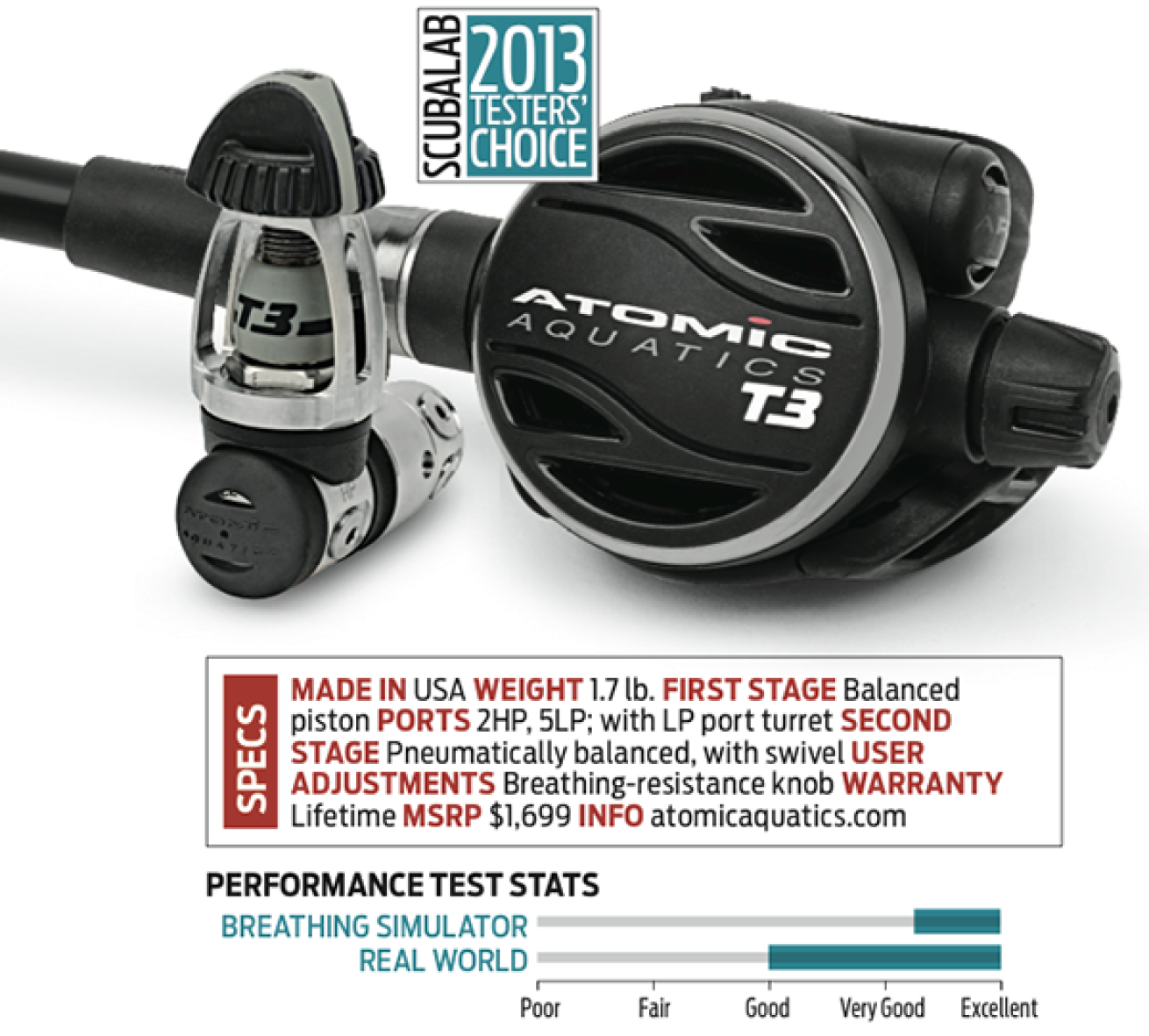
Elly WrayAtomic Aquatics T3
PERFORMANCE lightweight, attractive, machined from exotic metals and packed full of groundbreaking features and functions, Atomic’s “T” series regs are what diving dreams are made of. This year, a new high-performance, high-dollar T-reg has been released: the T3. Precision machined from solid titanium billet, with redesigned component parts to shave off even more weight, the T3 is the lightest, sleekest full-size reg around.
Performance-wise, it’s hard to beat. It turned in top scores on the breathing machine, sliding effortlessly through the standard test range and beyond. When the test reg was turned over to divers for the ocean work, there was a near riot to see who would take it down first. No one surfaced disappointed. From ease of breathing to dryness to bubble interference to the effectiveness of the user control, the T3 delivered the goods with style.
BOTTOM LINE Made for divers who want the best, virtually every tester put the T3 at the top of their Favorites list, making it the undisputed Testers’ Choice in this year’s Over $500 category.
Atomic Aquatics Z3
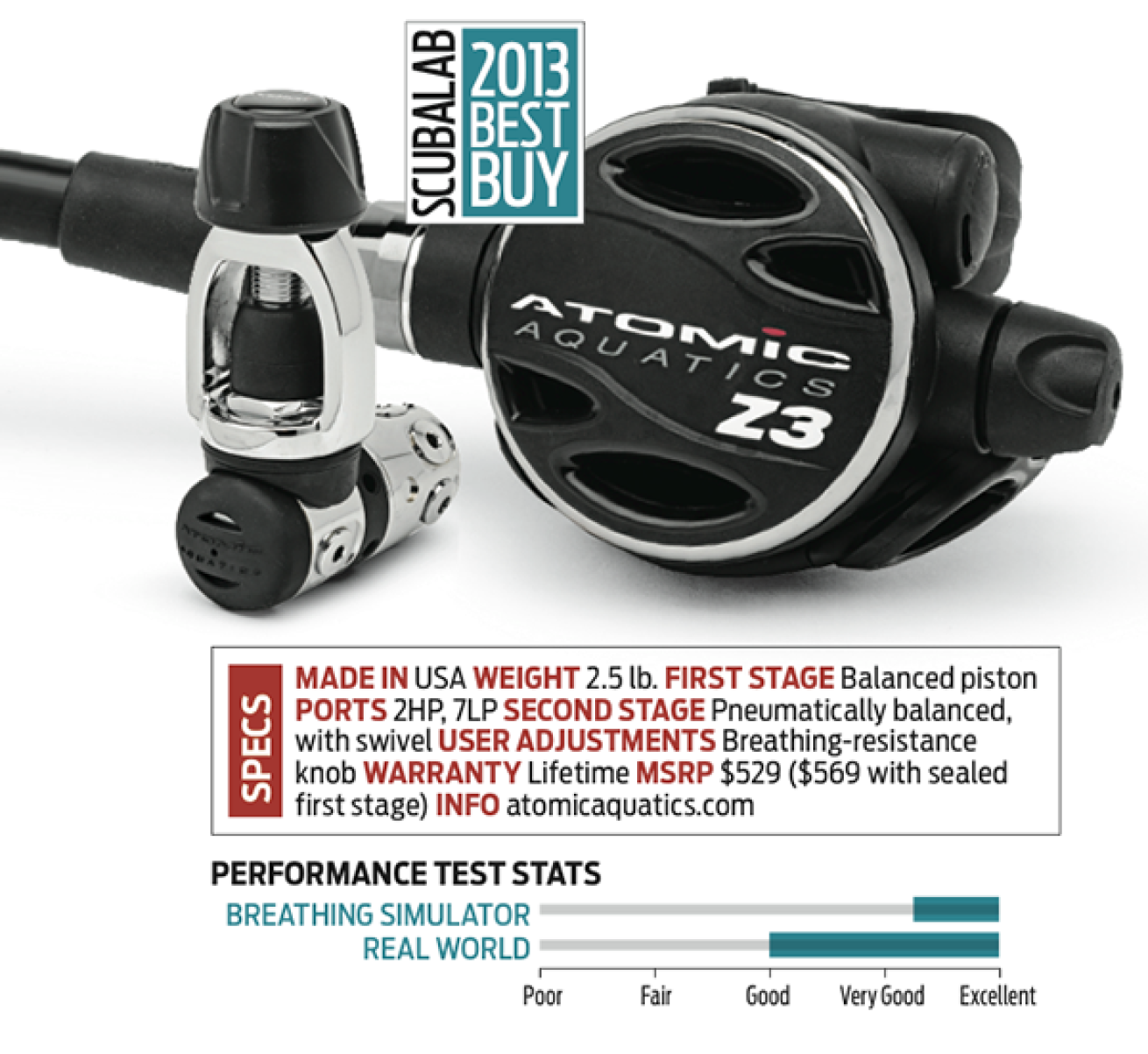
Elly WrayAtomic Aquatics Z3
PERFORMANCE First there was the Z1, then the Z2/ Z2x and now comes the Z3. While the T3 holds the title of most expensive reg in Atomic’s line, the Z3 holds down the opposite end of the pricing spectrum. This is due to less-exotic metals in its construction and fewer convenience features. However, what is not lacking is performance. The Z3 can hold up quite well to its pricier cousin both on the breathing machine and out in the ocean.
Delivering top scores for ease of breathing in the swimming position and rated high for dryness, test divers found the Z3 to be a comfortable, easy reg to breathe due to an efficient breathing-resistance knob, a very cool second-stage swivel and a dual-compound mouthpiece, all of which test divers deemed to be among the best of this test group.
BOTTOM LINE Turning in performance stats that rank right up with the T3 — and coming in at about a third of the cost — earned the Z3 this year’s Best Buy nod in the Over $500 category.
Dive Rite RG5300XT
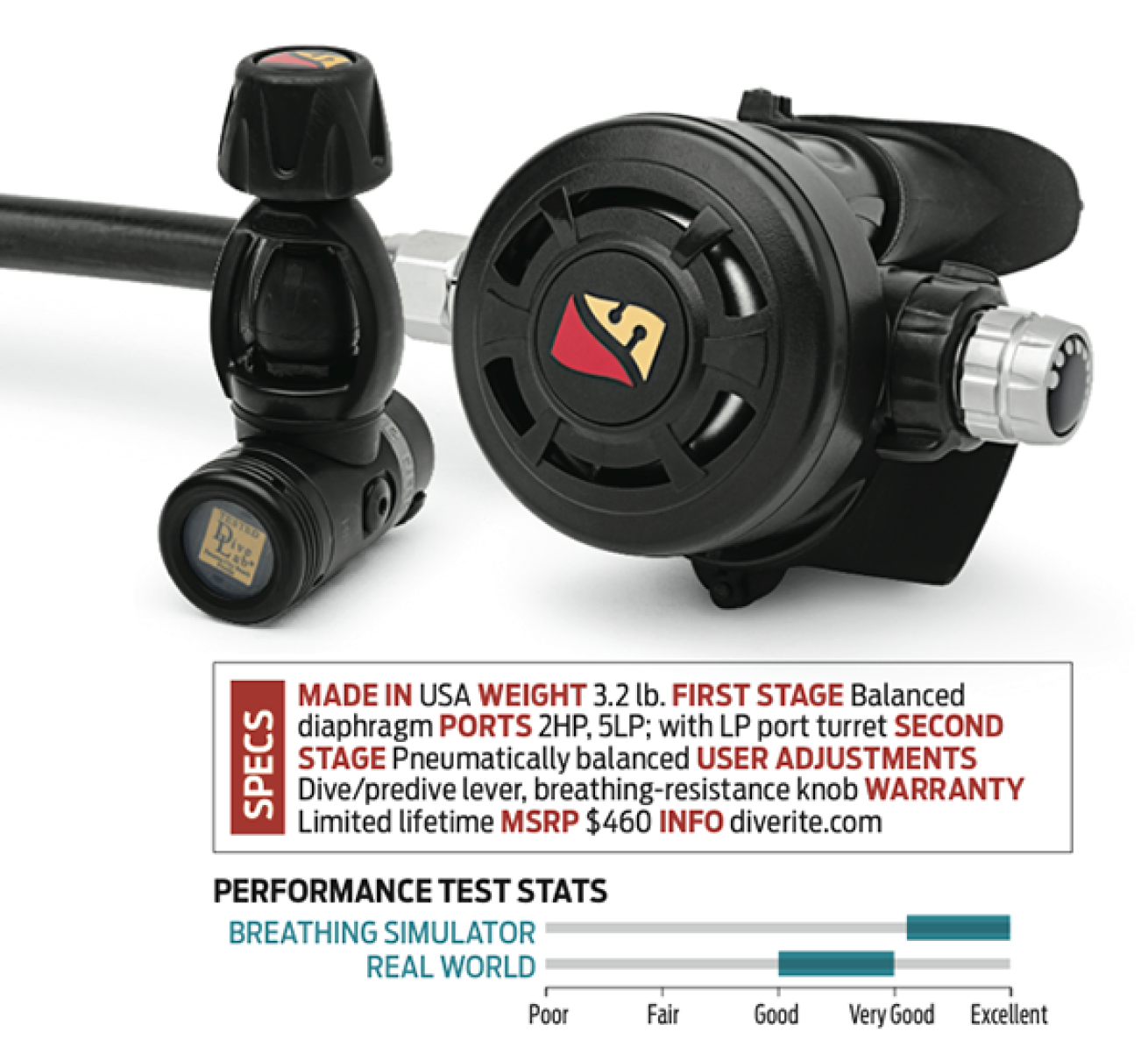
Elly WrayDive Rite RG5300XT
PERFORMANCE There was a delay in getting parts for the RG5300XT, so we weren’t able to subject it to a full test cycle. However, we did get a chance to put it on the breathing machine, where it pumped out some of the best work of breathing in its category. And those test divers who were able to take it into the ocean were impressed with the looks of the all-black, environmentally sealed first stage and well-machined second stage.
They found it breathed really smoothly in the swimming position and performed almost as well in alternate positions. The easy-grip dive/predive switch made quick work of controlling free-flows, and high marks were given to the inhalation-control knob with its knurled design for easy gripping. On the down side, the mouthpiece was considered way too soft, with bite tabs that felt like you could bite right through them (the manufacturer was aware of this and is currently replacing it with a stiffer mouthpiece).
BOTTOM LINE This is a really nice breather. We suspect it would have been a contender if it had been able to compete with the other regs in this category on a head-to-head basis.
Edge Epic 2012
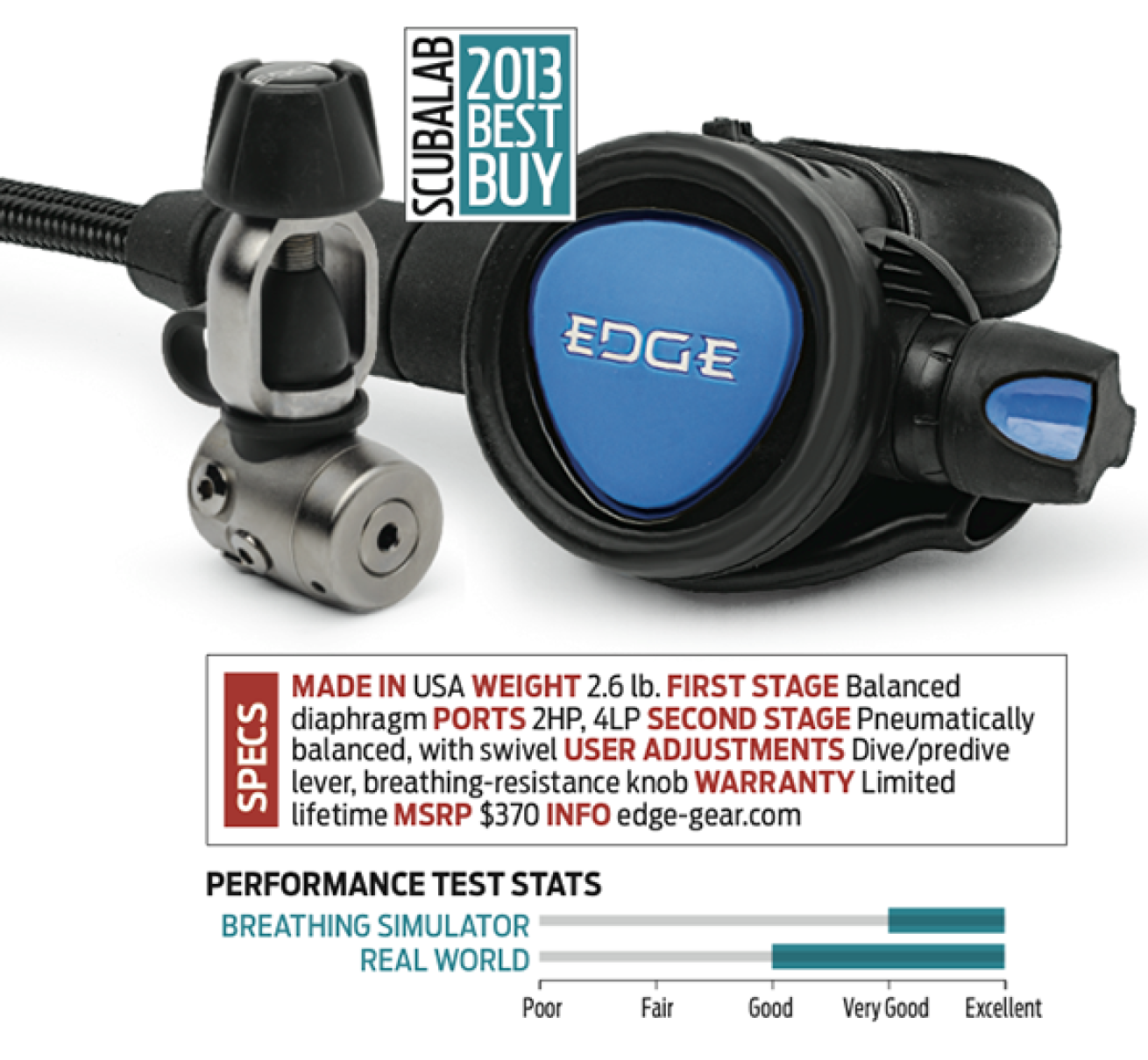
Elly WrayEdge Epic 2012
PERFORMANCE The epic 2012, with its cool-looking gun-metal tinted, environmentally sealed first stage, was the surprise performer in this year’s $500 & Under category. While it turned in impressive work of breathing scores on the ANSTI simulator, where it really showed its stuff was in the ocean tests.
An easy breather in all positions, this reg delivered dry air effortlessly. The purge cover is extremely soft yet forceful, which allowed for easy clearing. The inhalation-control knob was easy to grip and did a good job of regulating airflow. Test divers also found the dive/predive lever was effective, albeit a bit stiff, and the 360-degree ball swivel on the second stage was considered a nice extra touch. The dual-compound mouthpiece is similar to what you’d find on some high-end regs; most of the test divers really appreciated it.
BOTTOM LINE With its combination of user-friendly features, great performance and value-minded price, the epic 2012 came in as this year’s Best Buy in the $500 & Under category.
Edge EXP
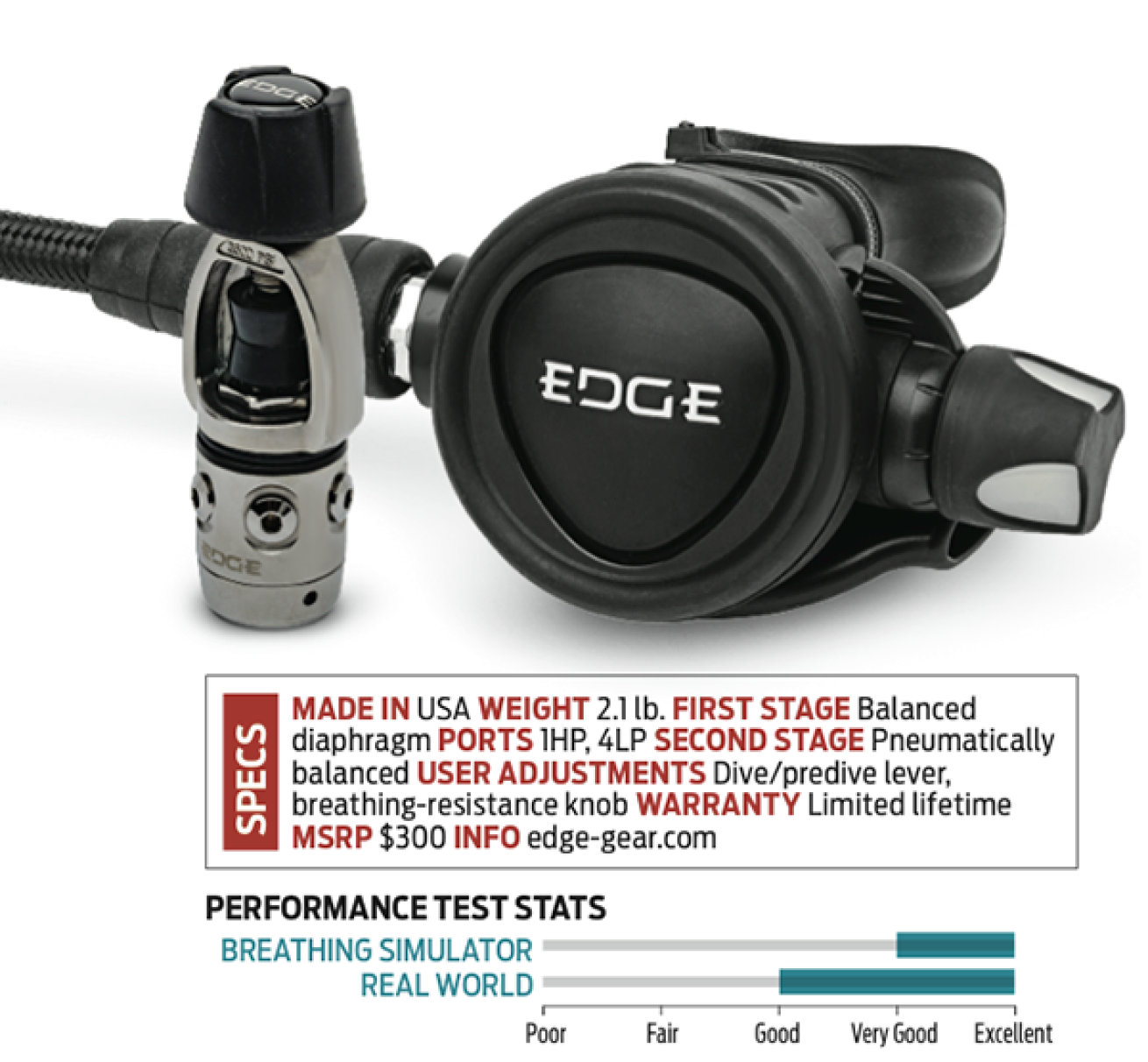
Elly WrayEdge EXP
PERFORMANCE The EXP is the little brother to the epic 2012. Its first stage is a bit smaller, and it has only one HP port; however, the second stage is virtually identical. It delivered excellent work of breathing in the RMV/depth-test level that most closely represents recreational diving, and above-average work of breathing in the next two test categories. In the water, test divers found the reg breathed dry and easy in all positions.
While a bit friskier than the epic, this was easily corrected by dialing back on the breathing-resistance knob. Divers really liked the EXP’s user controls, and actually found that the dive/predive lever was not as stiff as the one on the epic. The crew at edge suspect this difference was probably due to using slightly more lubrication on the EXP than the amount used on the epic 2012.
BOTTOM LINE For recreational divers on a tight budget, the EXP is a very affordable reg that delivers above-average performance.
SCUBAPRO MK11/R195
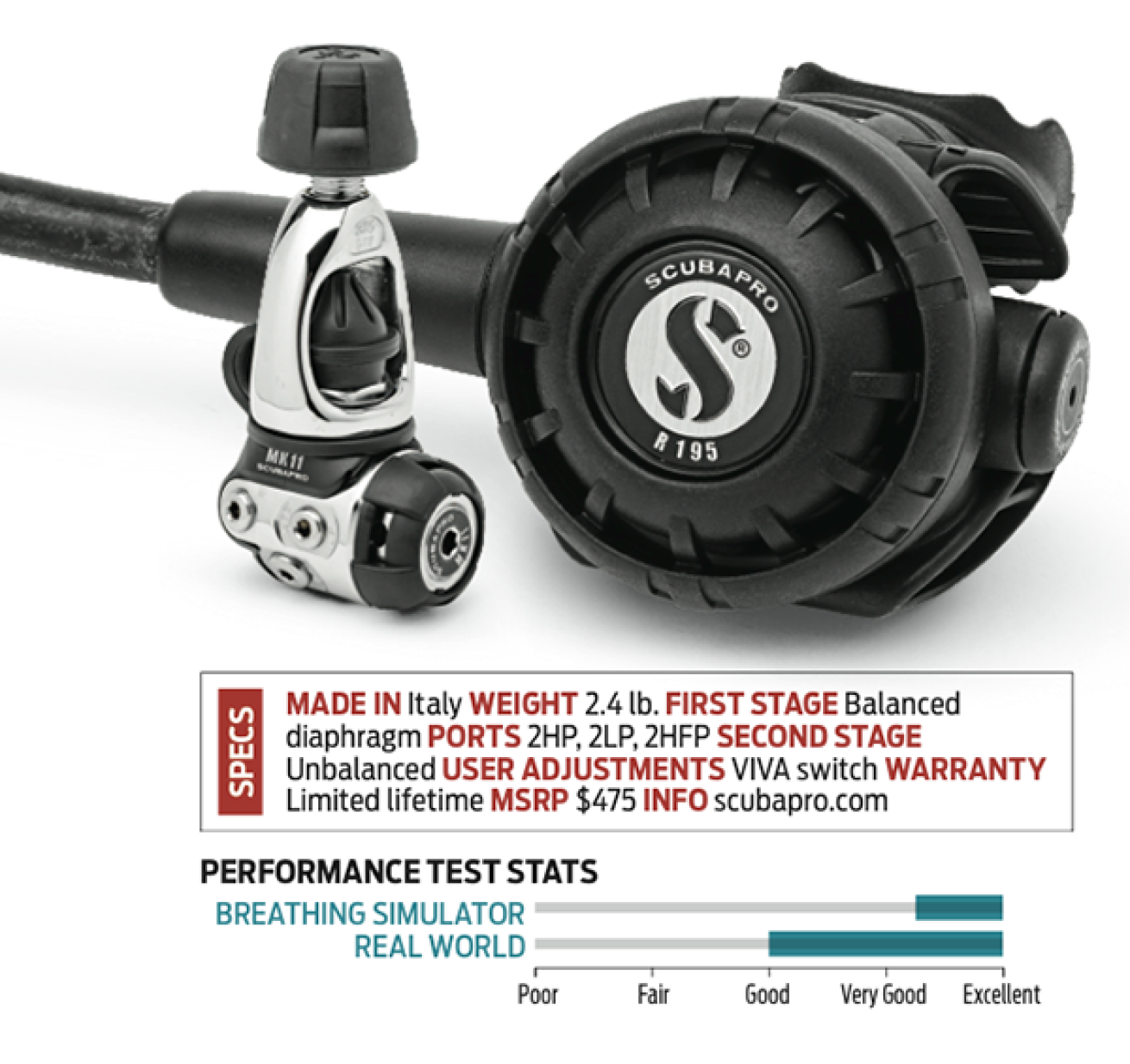
Elly WraySCUBAPRO MK11/R195
PERFORMANCE SCUBAPRO has taken its time-proven MK11 first stage and teamed it with a new second stage. The R195 is a modernized version of SCUBAPRO’s classic R190, which was known for its reliability. This new model comes with an easy-to-grab VIVA switch and a reversible hose-attachment feature, in case you want to use it as an octo.
The MK11/R195 was one of only three regs in this category to earn top scores across the board on the breathing machine’s standard reg tests, and the only model able to qualify as a muscle reg, proving you don’t have to spend a pile of money to get lots of reserve capacity. In real-world diving, the reg proved to be a smooth, dry breather with minimal bubble interference. It feels light in the mouth, offers excellent purge action and the VIVA switch is easy to use and effective in controlling free-flows.
BOTTOM LINE The MK11/R195 has an impressive pedigree and proved to be an even better breather than its predecessor. It came in second on test divers’ Top 3 Favorites list in this price category.
SCUBAPRO MK17/G260
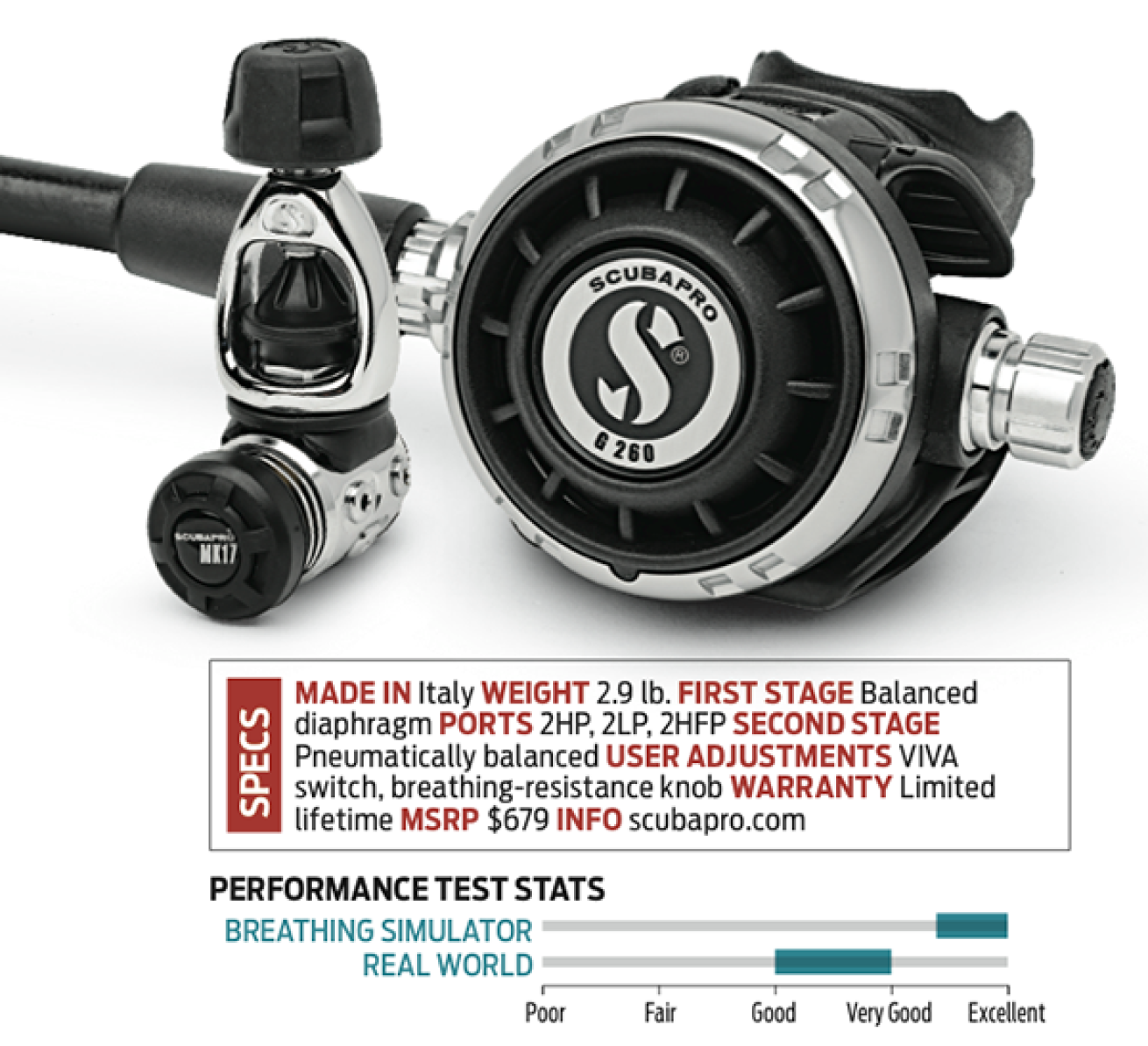
Elly WraySCUBAPRO MK17/G260
PERFORMANCE The MK17/G260 is designed for harsh environments and cold-water use. Its first-stage anti-freeze system protects internal parts with ice-repellent coatings, and a dry, ambient chamber system keeps water and contaminants out of the workings. The G260 second stage is made with metal components in the inlet tube, orifice, inhalation-control knob and hose connector to optimize cold-water performance. Of course, you don’t need cold water to appreciate this reg.
Test divers found it a capable breather in high 60-degree water, able to deliver consistent airflow in all positions without a hint of dampness. Its VIVA switch and inhalation-control knob make it easy to prevent free-flows as well as regulate breathing effort. Being a SCUBAPRO reg, it shows well on the breathing machine too; deep depths and aggressive-breathing rates don’t bother it a bit.
BOTTOM LINE: The Mark 17/G260 is an ideal system for cold-water divers, and its left/right hose-attachment option makes it ideally suited for tec diving too.
SCUBAPRO MK25/S600
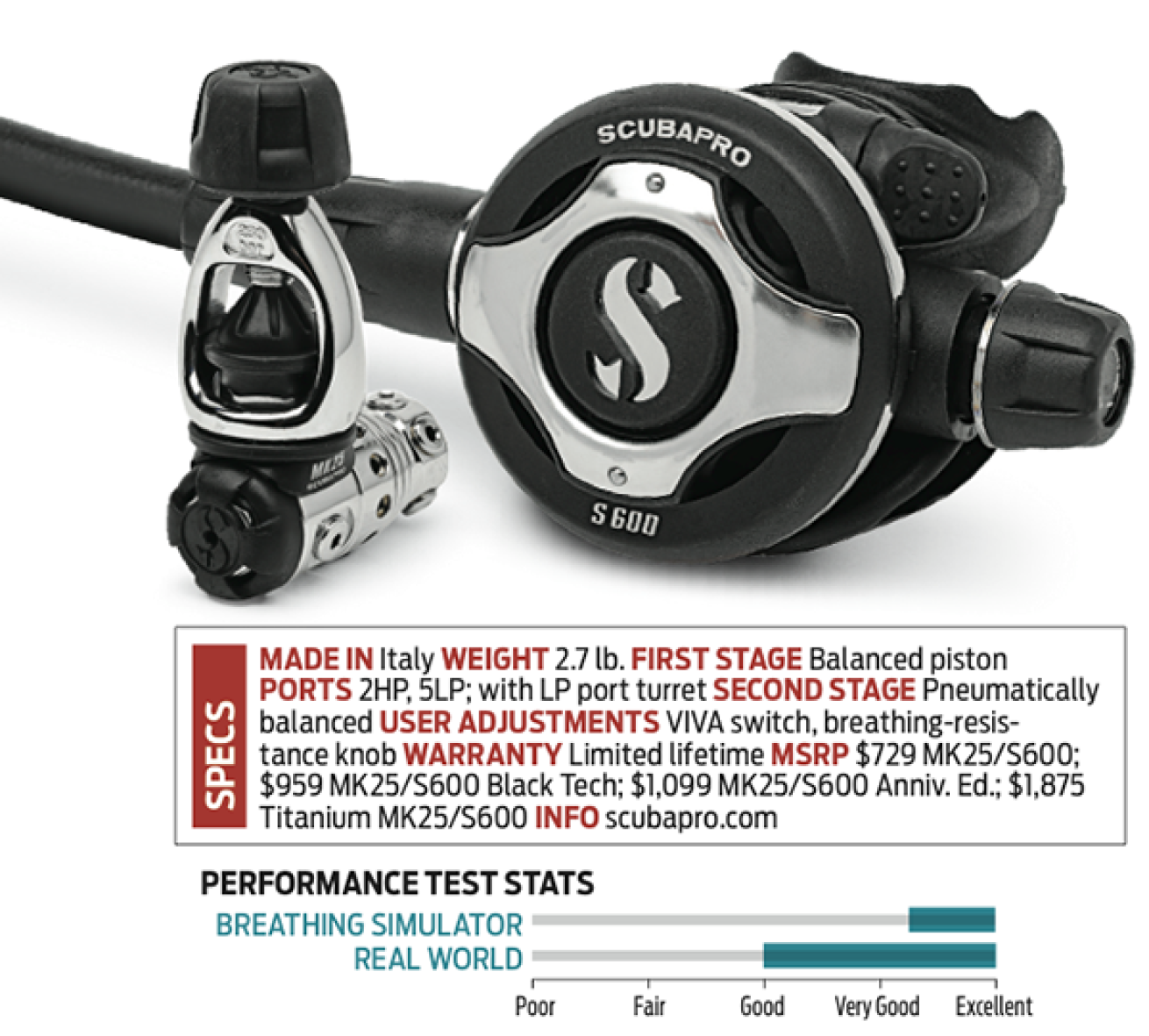
Elly WraySCUBAPRO MK25/S600
PERFORMANCE This renowned performance reg has been restyled, and this year is available in four versions: the MK25/S600, the MK25/S600 Black Tech, the Titanium MK25/S600 and, to celebrate SCUBAPRO’s 50th year in business, the MK25/S600 Anniversary edition. They each offer unique cosmetics, coatings and construction materials, but they have one thing in common: awesome performance.
The reg is known for its low work of breathing and its tremendous reserve capacity, and this year’s test model (a MK25/S600) proved to be no different. Turning in excellent work of breathing in our standard ANSTI breathing tests, the reg eased over into muscle-reg territory and just kept on going, outpacing all models, past and present, in depth and breathing rates. Out in the real world, test divers loved this reg. Upside down, heads-up or just swimming normally, the reg breathed flawlessly. The inhalation-control knob is effective and so is the VIVA switch, although divers dinged it for being a tad small.
BOTTOM LINE No doubt about it, this is one standout breather. It came in a very strong second place on test divers’ favorites lists in this category.
Seac Sub X-10 Pro
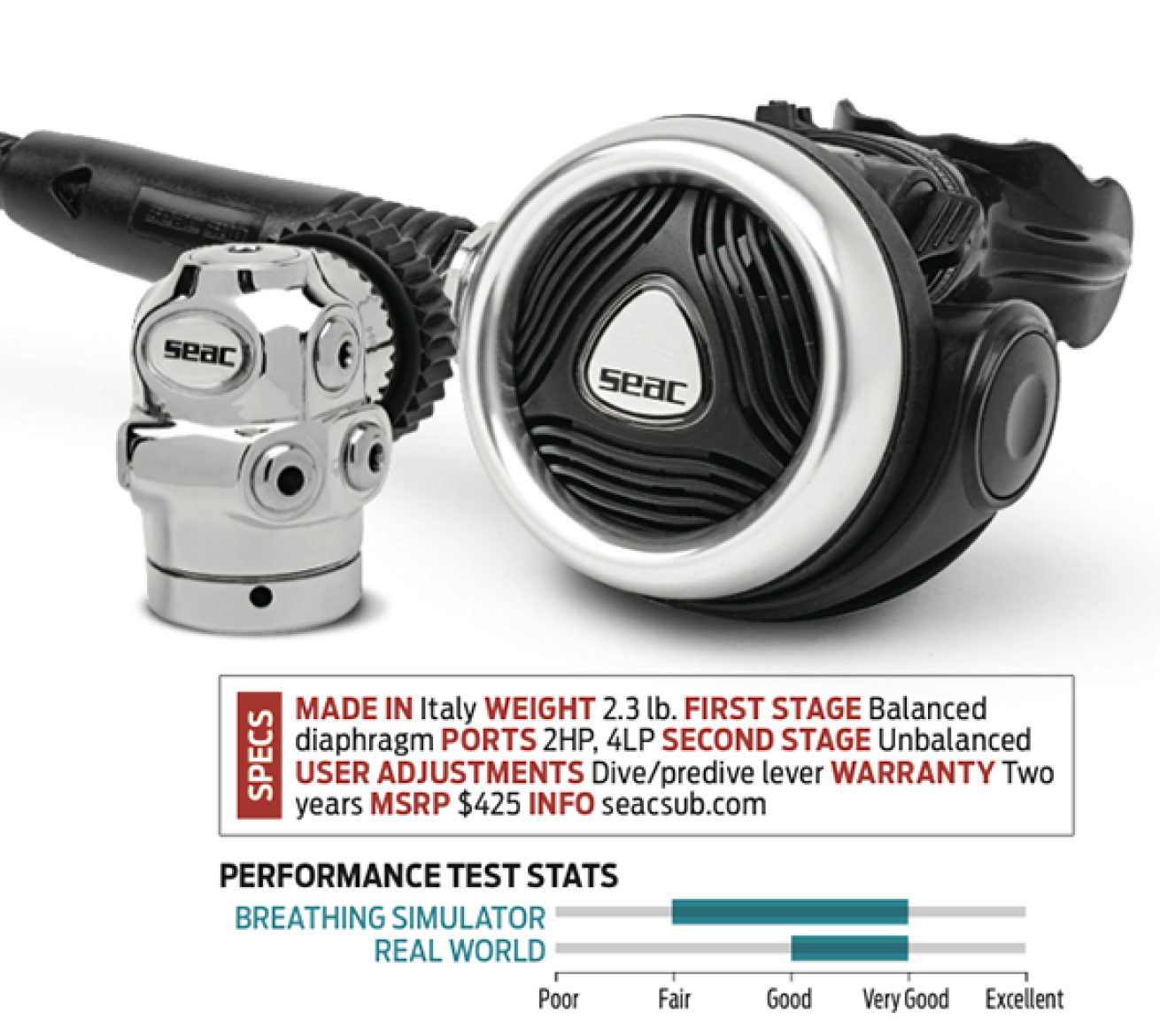
Elly WraySeac Sub X-10 Pro
PERFORMANCE The X-10 Pro from Seac is a good-looking reg. Its compact first stage has a polished chrome finish, and the DIN version we tested makes for a compact package. The second stage is a simple design with a small dive/predive switch that can be a little hard to grab when wearing thick gloves. Also, the purge cover, while flexible, has a bit of wiggle to it that feels a little funny but doesn’t inhibit functionality.
Beyond these minor gripes, this is a pretty solid reg. Test divers found it to be a comfortable breather that delivered good airflow, was very dry in all positions, and had minimal bubble interference. On the ANSTI machine, it generated very good work of breathing in the test category level that most closely represents recreational diving, and fair to good performance when put under stress — although it couldn’t quite handle the most extreme RMV/depth-test level.
BOTTOM LINE The X-10 Pro gets the job done, delivering respectable reg performance at a decent price. And a budget-minded diver can’t ask for more than that.
Sherwood Scuba Blizzard
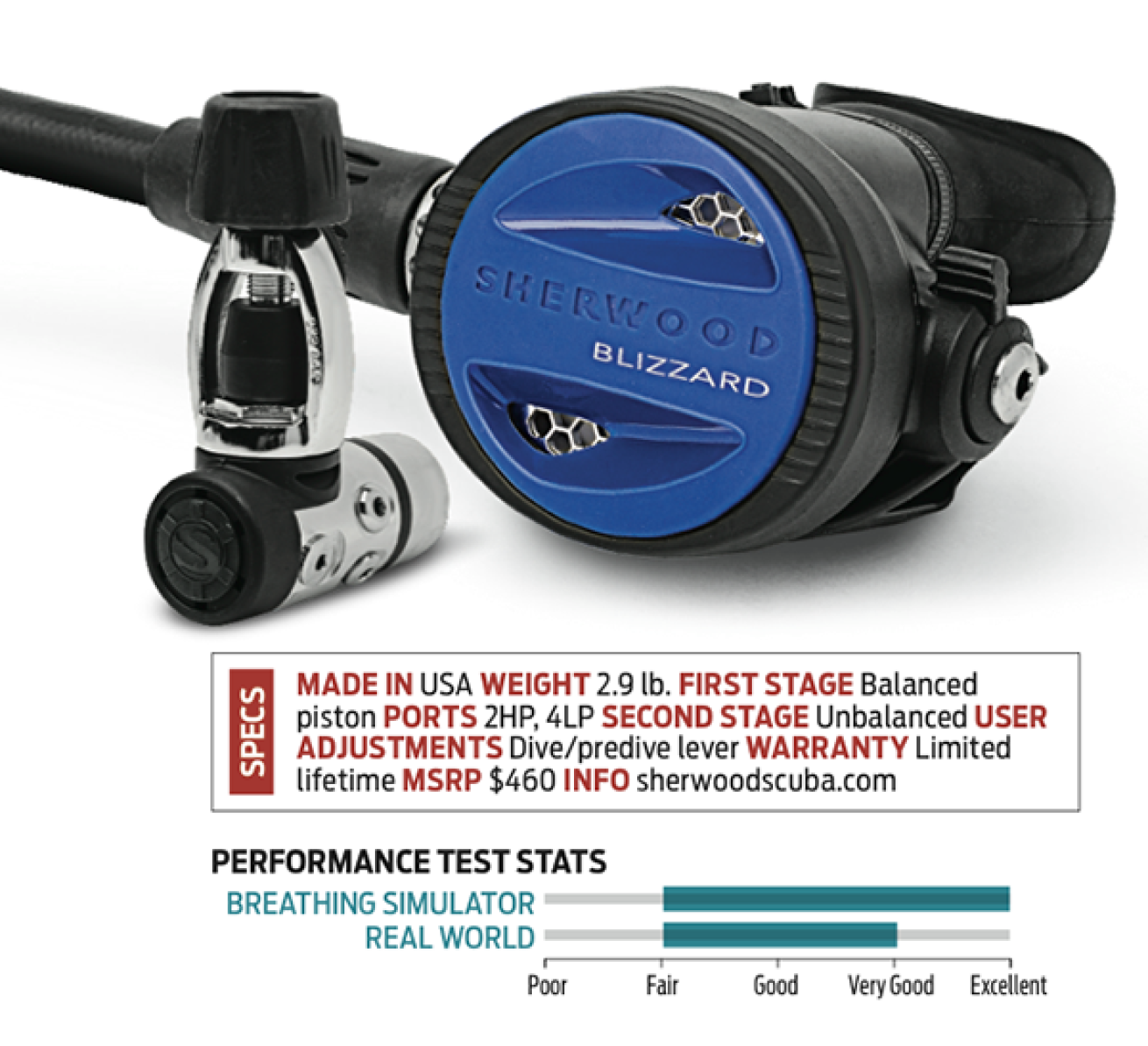
Elly WraySherwood Scuba Blizzard
PERFORMANCE: The Blizzard has a reputation for reliability, and for being easy — and inexpensive — to service. Designed for cold-water diving, it sports a dry-sealed first stage, its second-stage valve body is Teflon coated to reduce ice buildup and a heat-retention vane helps collect warmth from exhalation to prevent freeze-ups.
Breathing-machine tests revealed a relatively low work of breathing. In the ocean, it delivered air smoothly in the swimming position, and it also did a good job of delivering air in alternate positions — although in the heads-down position, test divers found that the reg breathed a bit wet. They also found the purge cover to be pretty stiff compared with other regs in this group. The dive/predive lever was rated effective in tamping down free-flows on the surface.
BOTTOM LINE: This is a simple reg that makes a pretty good showing on the breathing machine as well as out in the ocean.
Sherwood Scuba Oasis
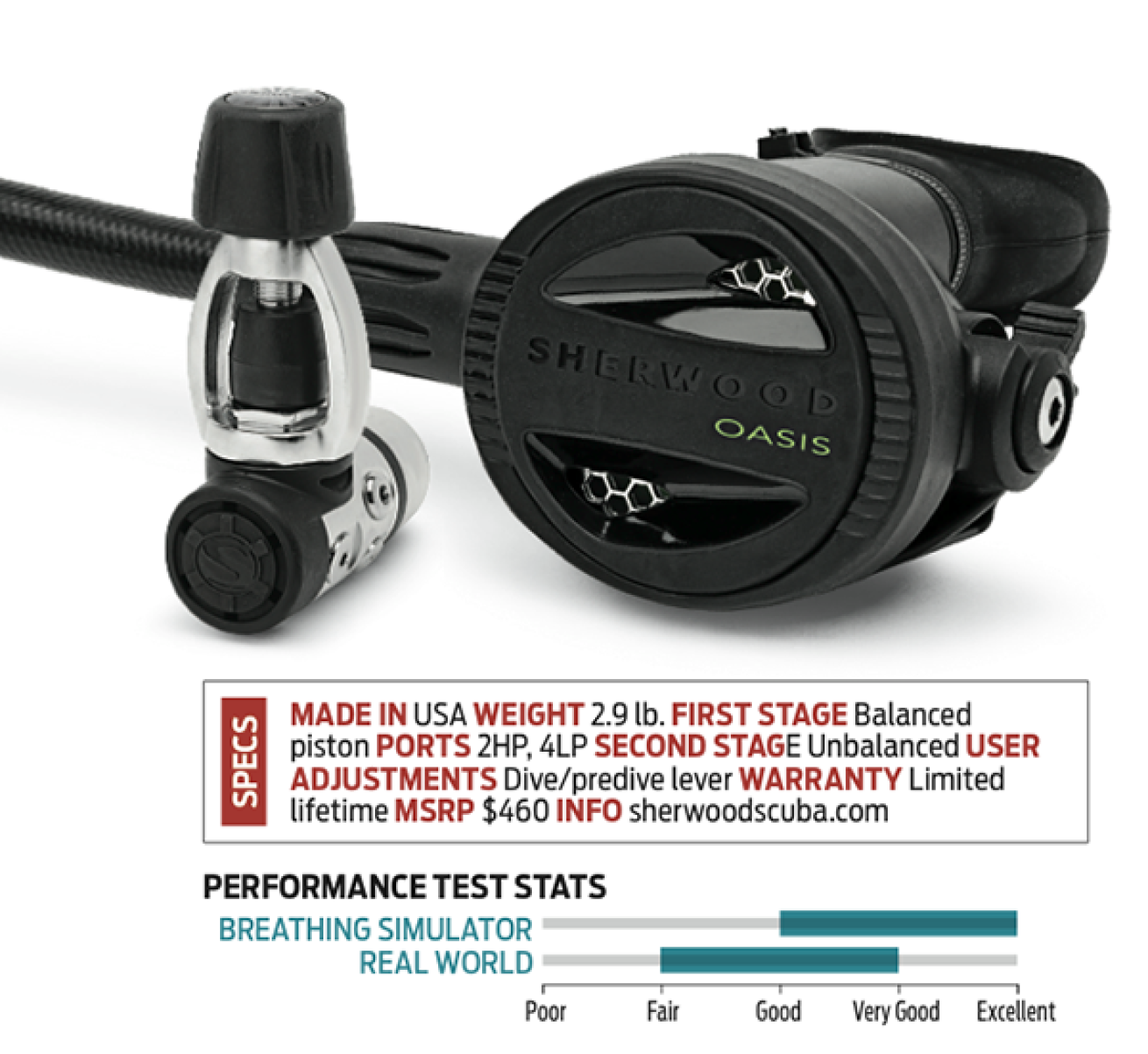
Elly WraySherwood Scuba Oasis
PERFORMANCE The Oasis shares the same first stage as the Blizzard, but while the Blizzard’s second stage is set up to handle cold-water diving scenarios, the Oasis’ second stage is designed to address dry-mouth issues. Built into the second stage are a pair of Moisture Retention Vanes that collect vapor from exhaled air and return it to the diver on inhalation. This reduces the tendency some divers have to suffer from cottonmouth from breathing compressed air.
Performancewise, the Oasis was pretty much on par with the Blizzard. Breathing-machine tests showed it actually is able to handle the deepest test depths a little better than the Blizzard, but they both deliver excellent work of breathing at the level most representative of recreational diving. Ocean tests unveiled similar results too: a smooth breather in the swimming position but wet in the heads-down position, a stiff purge cover and an efficient dive/predive lever.
BOTTOM LINE For divers who have trouble with dry-mouth, this reg could be what you’ve been looking for.
Sherwood Scuba SR2
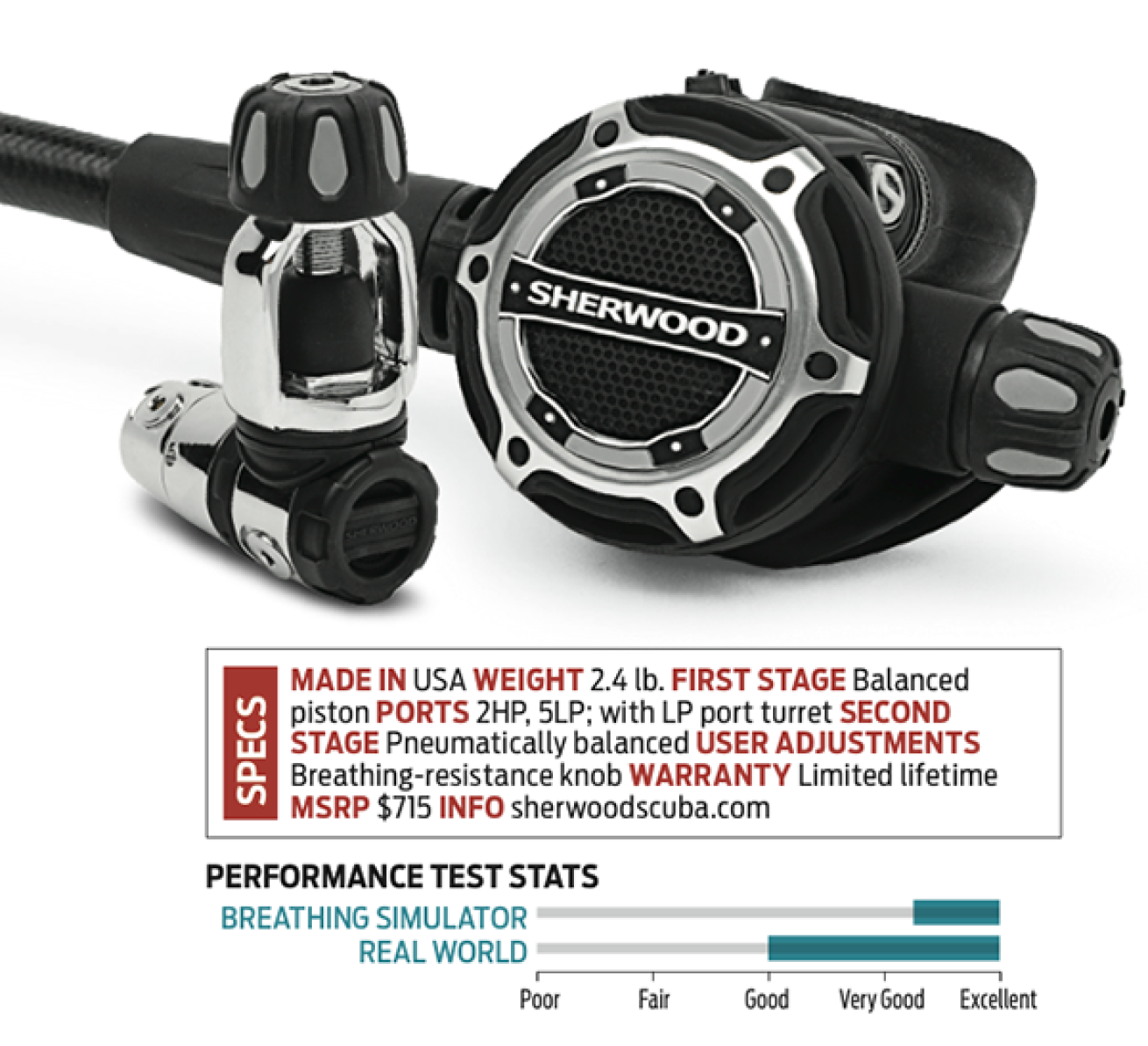
Elly WraySherwood Scuba SR2
PERFORMANCE This dry-sealed balanced-piston first stage and compact second-stage combo did itself proud on the ANSTI machine, easily conquering each RMV/depth-test level with excellent work of breathing scores. And it didn’t stop there: The SR2’s performance in a battery of muscle-reg tests — where the envelope was aggressively pushed in terms of depth and breathing rates — was exceeded only by the MK25/S600. Underwater, the SR2 delivered dry and easy breathing in all positions.
Divers gave it thumbs-up all around — except for the mouthpiece, which the majority of test divers found to be too small for their tastes, but by no means a deal-breaker. They were impressed with the super-flexible purge cover that produced an effortless yet forceful clearing action, earning it the top scores in that test category. Divers also liked the single control knob that simultaneously adjusted for both Venturi control and breathing resistance.
BOTTOM LINE The SR2 has a solid reputation in the high-performance arena and is capable of delivering lots of reserve performance when needed.
Zeagle Onyx CW
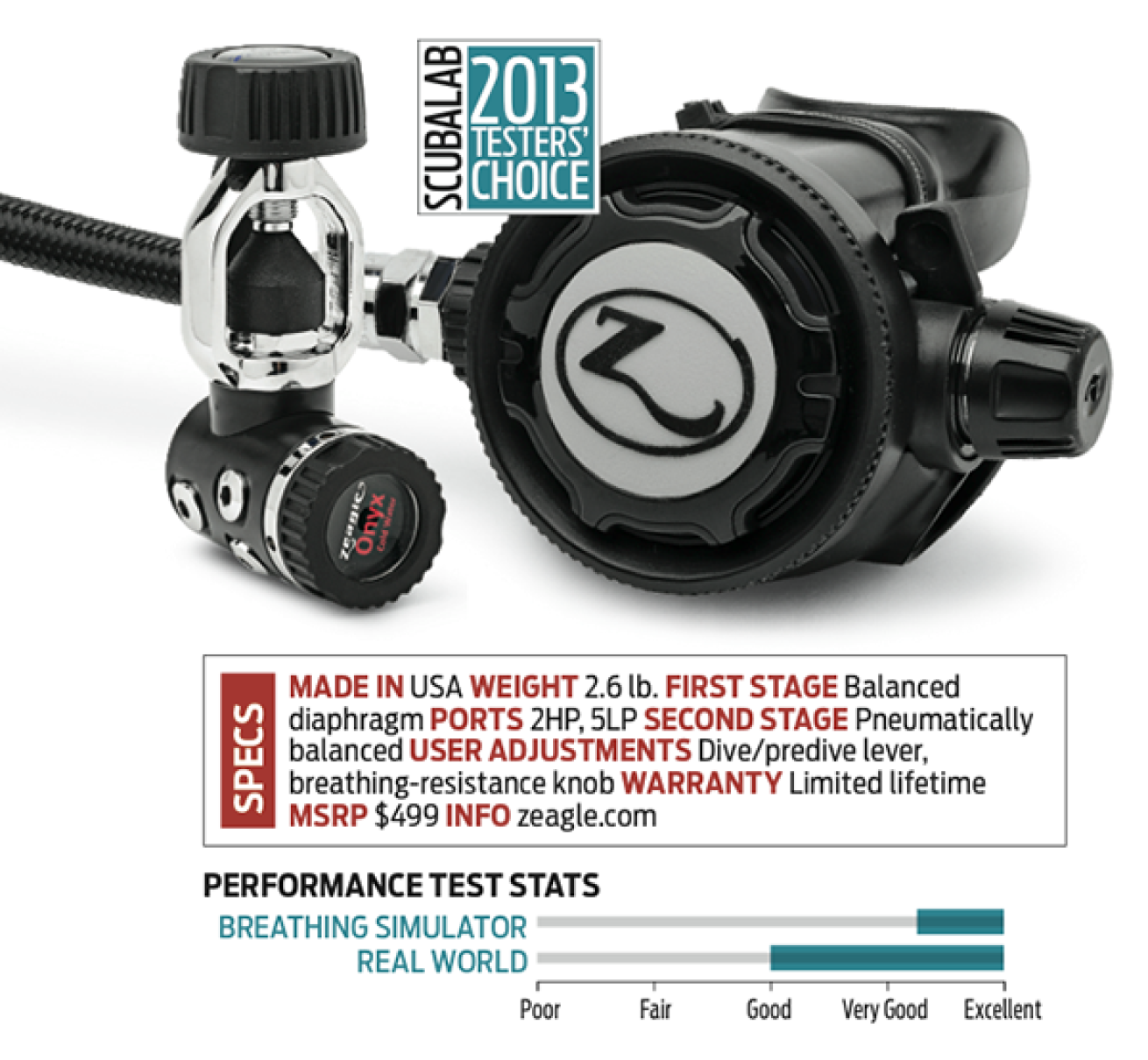
Elly WrayZeagle Onyx CW
PERFORMANCE When the Onyx first came out a couple of years ago, it earned high marks as an easy-breathing reg. This year Zeagle added a dry-seal system to the first stage and a heat sink to the second stage, creating the Onyx CW (for cold water).
Performancewise, not much has changed. The reg is still a giant-killer on the ANSTI machine, able to handle all standard RMV/depth-test levels with some of the lowest work of breathing in this category. This top-drawer behavior extended into the ocean, where test divers lauded it for its effortless, bone-dry breathing. The mouthpiece is rather large with long bite tabs; some test divers liked it, others found it a bit too much to swallow. It is equipped with the softest purge cover and best purge action in this category, and its user controls were rated among the best.
BOTTOM LINE The Onyx CW was the only reg to end up on every test diver’s Top 3 Favorites list, making it the unanimous pick for Testers’ Choice in the $500 & Under category.
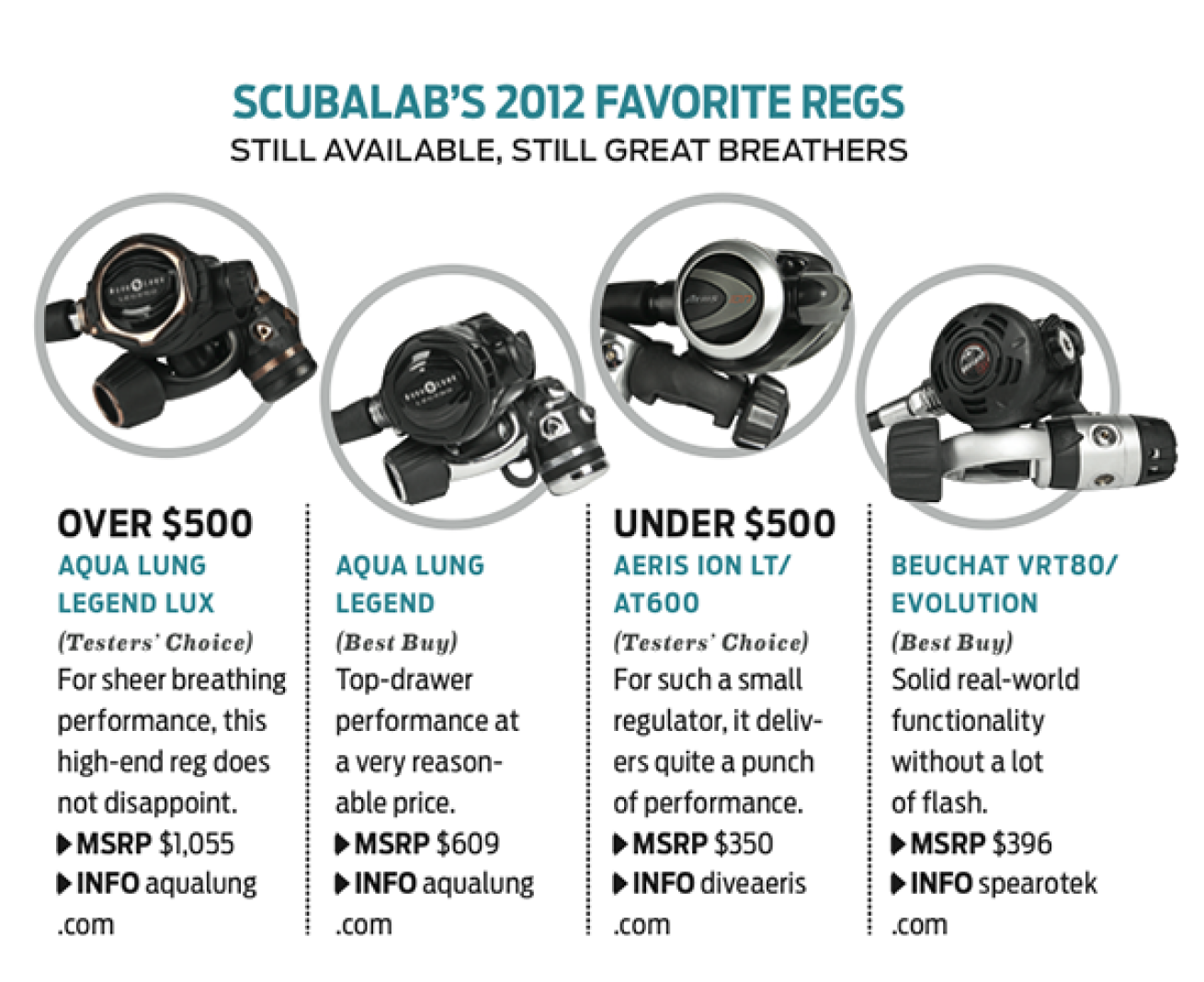
Elly WrayStill available, still great breathers.
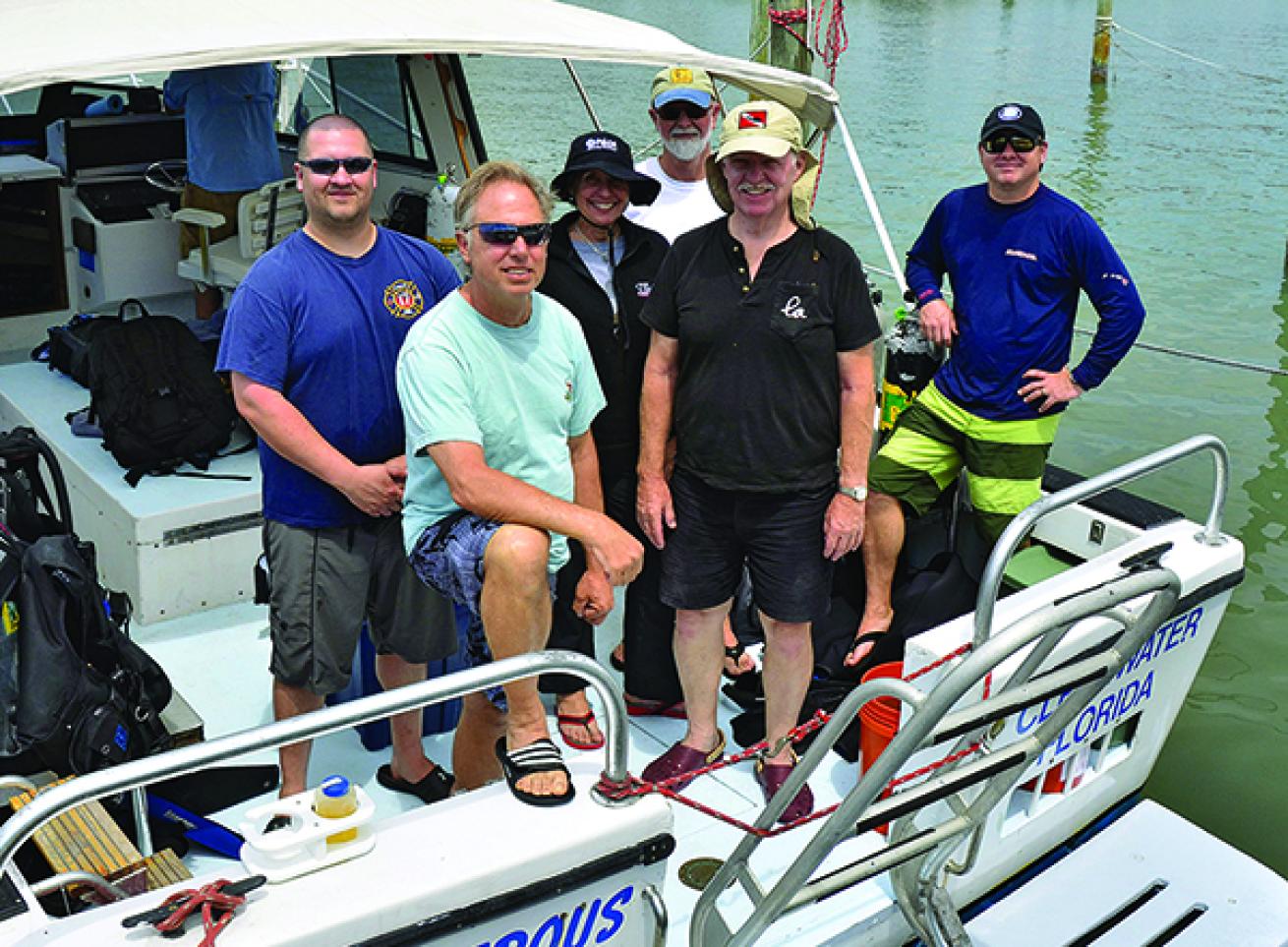
Elly WrayScubaLab would like to thank Mike Ward of Dive Lab, Panama City Beach, Florida (divelab.com), for his work on the ANSTI breathing simulator, and Capt. Ryan Nelson of Tanks-A-Lot Dive Charters, Clearwater, Florida (tanksalotdivecharter.com), for his help with the in-water portion of the tests.
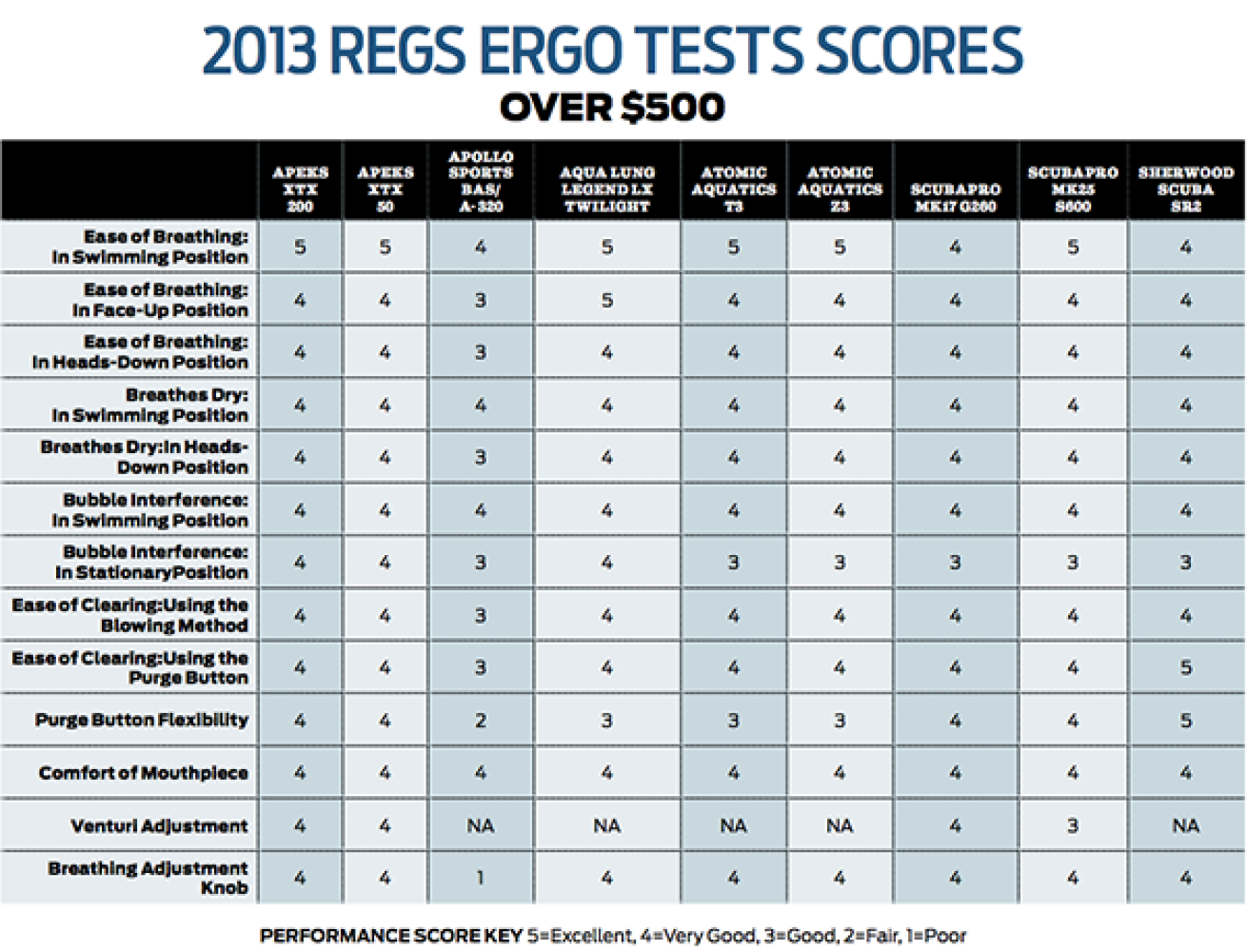
StaffErgonomic Test Results from the 2013 ScubaLab Reg Review.
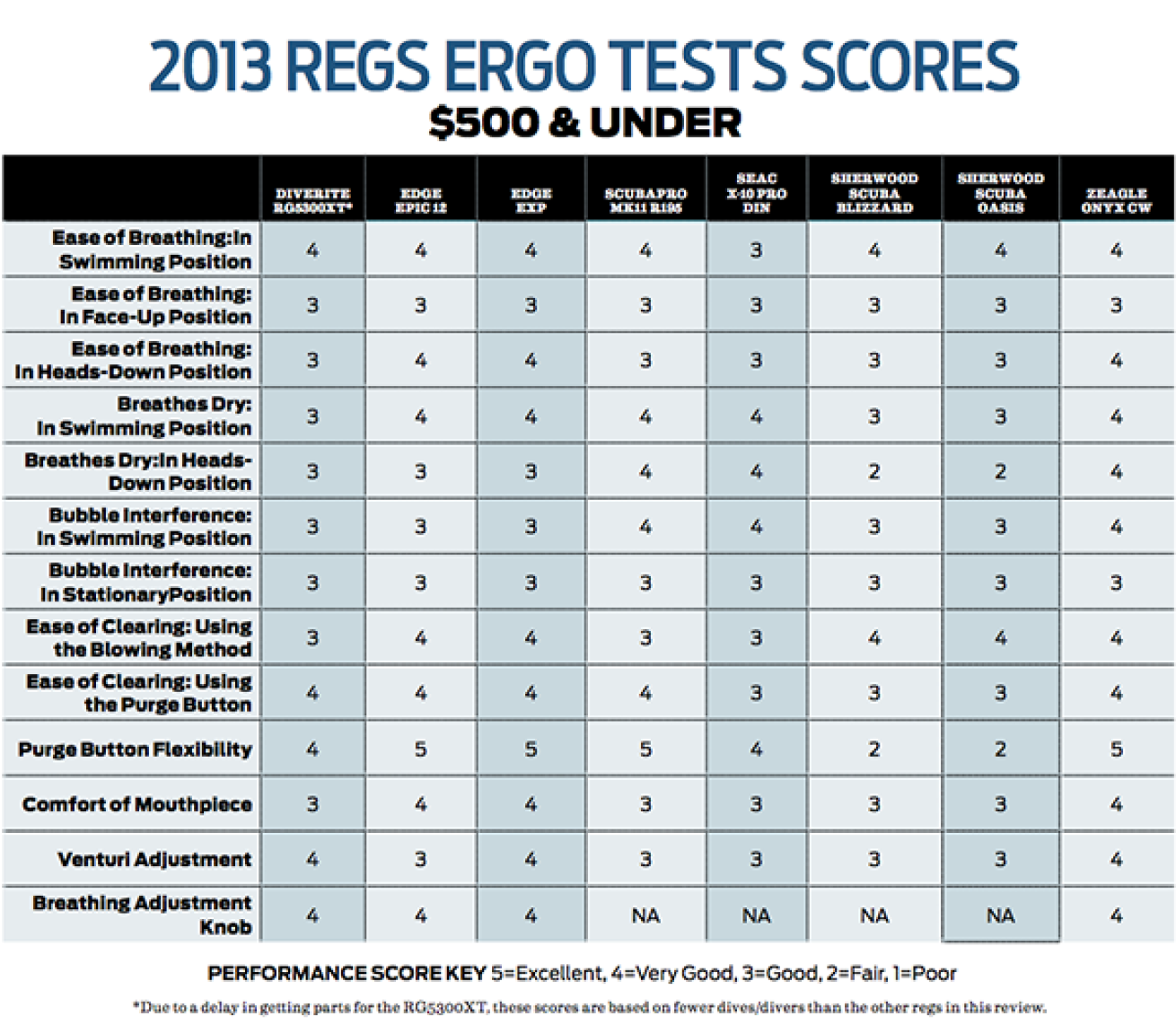
StaffErgonomic Tests results from the 2013 ScubaLab Reg Review.
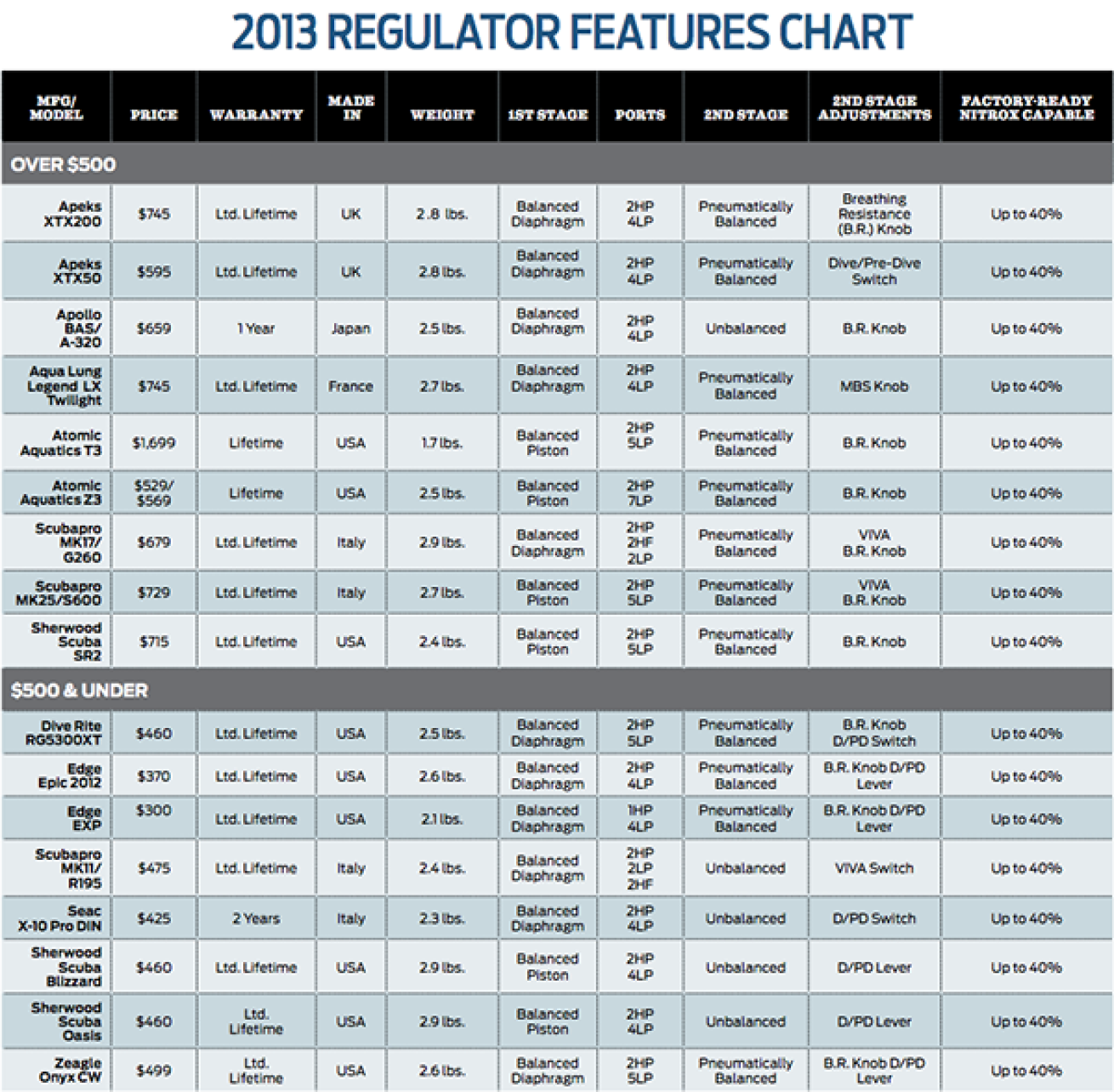
StaffList of features on each regulator from ScubaLab's 2013 Reg Test.
How We Test: Regulators
Breathing Machine Tests:
>> All regs are tested as received from manufacturers.
>> Regs with user adjustments are adjusted for testing at the no-leak/free-flow point. Regs are tested on the breathing machine in a face-forward position, per industry-testing norms. (Note: Regs breathe better in a facedown position, more typical for a recreational diver.)
>> Following a surface check, each reg is tested at three different breathing rates, known as RMVs (Respiratory Minute Volumes, basically the amount of gas that can be ventilated through the lungs in one minute), at three depths, for a total of four RMV/depth combinations. These breathing rates were chosen to enable us to:
- simulate a recreational diver’s breathing rate.
- conform to recognized industry testing parameters for purposes of comparison.
- surpass normal breathing rates to determine reserve capacity (the ability to continue to deliver gas smoothly and easily, even at extreme depths and breathing rates).
>> Simulator tests are not intended to pass or fail regulators, but rather to scientifically gauge their performance based on controlled conditions.
Ergonomic Tests Explained:
ScubaLab staff evaluates each regulator in the water in 13 basic areas. Performance is tracked by numeric scores (1 to 5 – 1 being Poor, 5 being Excellent) and written comments, recorded at depth, while regs are actually being used.
Ergo Test Categories:
- Ease of breathing, swimming position: How well does the regulator deliver air when moving forward in a standard swimming position?
- Ease of breathing, face-up position: How well does the regulator deliver air when you are at depth and looking up toward the surface?
- Ease of breathing, heads-down position: How well does the regulator deliver air when you are at depth and in an inverted position?
- Wetness, swimming position: How dry does the reg breathe?
- Wetness, heads-down position: When in heads-down and face-up, how dry does the reg breathe?
- Bubble interference, swimming position: Taking into account all regulators have bubble interference to a certain degree, when moving through the water, how well does the reg deflect bubbles from your field of view?
- Bubble interference, stationary position: Taking into account all regs have interference to a certain degree, how well does it deflect bubbles from field of view when stationary?
- Ease of clearing, exhalation method: How much force is required to clear the regulator by exhaling?
- Ease of clearing, using purge button: How difficult is it to find and use the purge? How forceful is it?
- Purge-button flexibility: How stiff or pliable is the purge button/cover, and how efficiently does it clear?
- Comfort of mouthpiece: How comfortable is the mouthpiece?
- Venturi lever adjustment: Is the Venturi lever easy to find and use?
- Breating adjustment knob: Is the adjustment knob easy to find and use? Does it do its job in a reasonable manner?
---
Looking for more ScubaLab testing? Check out more of our gear reviews:

